Tag: KILZ 3 Premium Primer
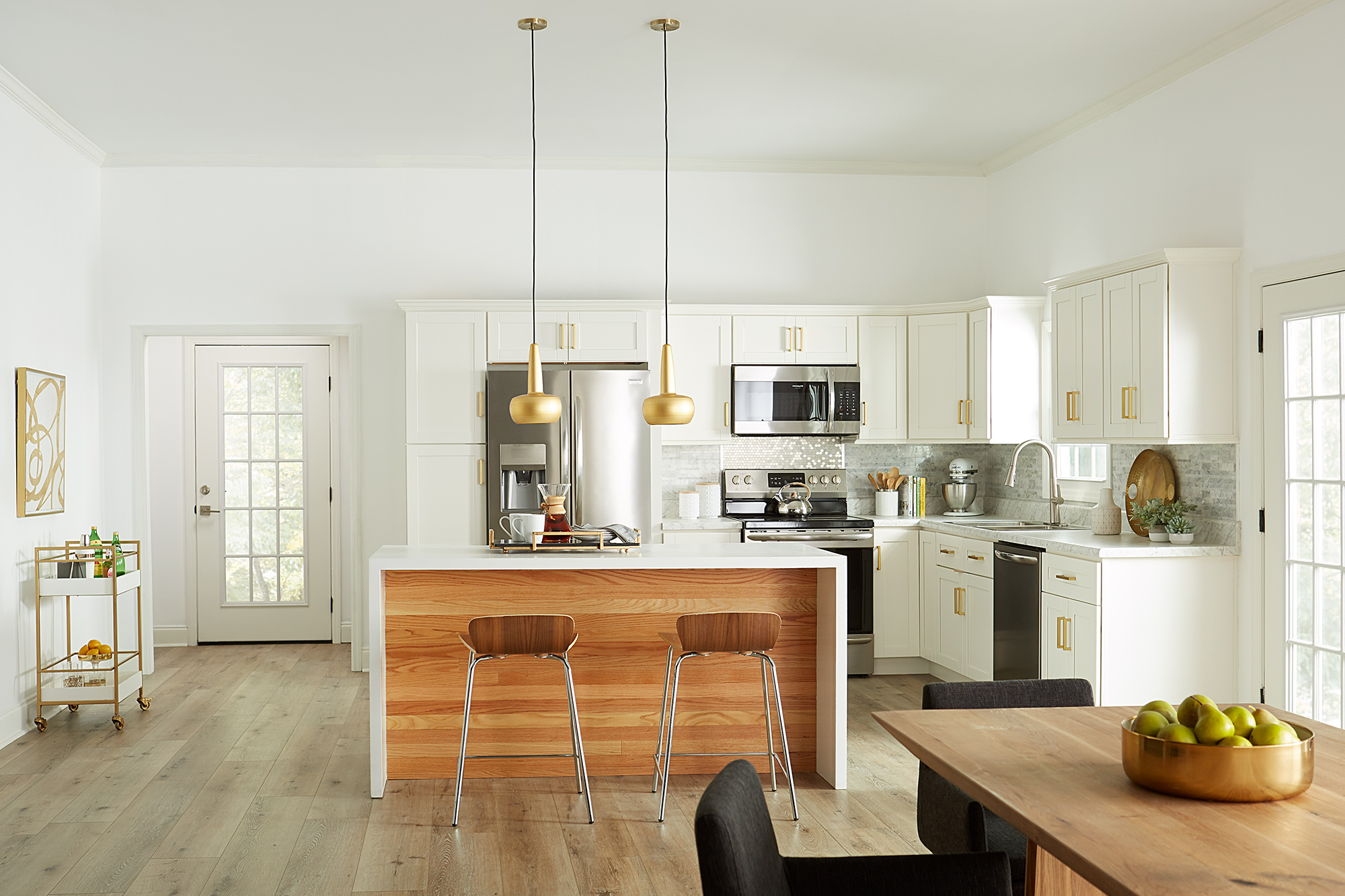
A Fresh Kitchen Makeover
October 15, 2021A dated and uninspiring kitchen is transformed into a fresh cooking and entertaining space in this remarkable kitchen transformation. The original kitchen did little to encourage people to spend time in the space or inspire home-cooking or hosting. To liven up this kitchen and create a welcoming space, we focused our efforts on a simple yet powerful paint job and some key design upgrades.
For this makeover, we chose KILZ 3® Premium Primer because it offers adhesion and a mildew resistant finish on the primer film, ideal for moisture-prone areas like kitchens where water, steam, and even tough liquids like oils are commonplace. This primer is also high hide, meaning you can apply it directly over old colors (even darker ones!) and still be able to paint a bright white topcoat to finish.
Once the primer was applied and allowed to dry, we top coated with Magnolia Home by Joanna Gaines® paint in True White to add a fresh, renewing sense of cleanliness to the space. In providing a stark blank canvas, it allows everything else in the kitchen to shine. It is calm and mindful and creates a sense of renewal.
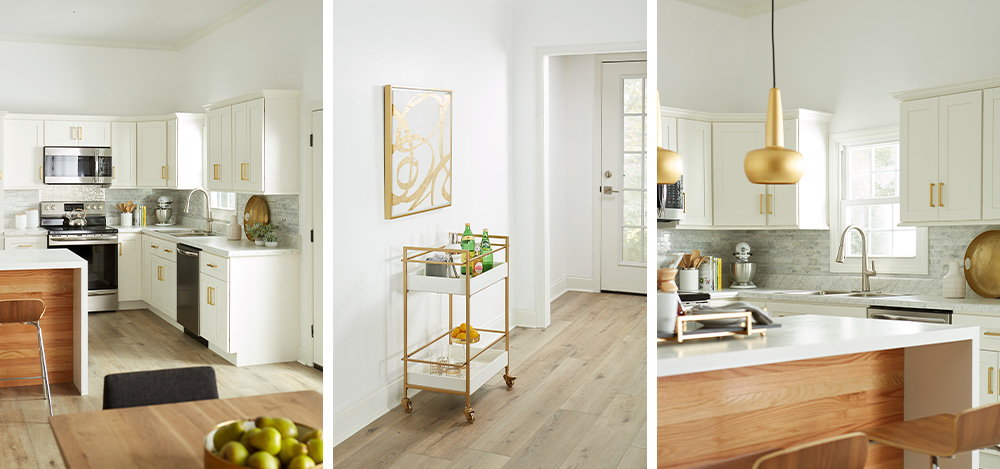
With the walls reset, our focus shifted to the overall color palette for the room. We chose a neutral combination of white, brown, and black. Dark colors were kept to a minimum, with a few mid-century modern accessories – including soft metallic pendant lights, low-rise barstools, a modern drink cart and simple white ceramic food canisters– providing welcoming aesthetic accents in key areas of the room. And to allow for more entertaining in the space, we brought in a larger dining table with additional seating.
This kitchen makeover is proof that a simple color change with primer and fresh coat of paint can be the perfect foundation for a stunning transformation.
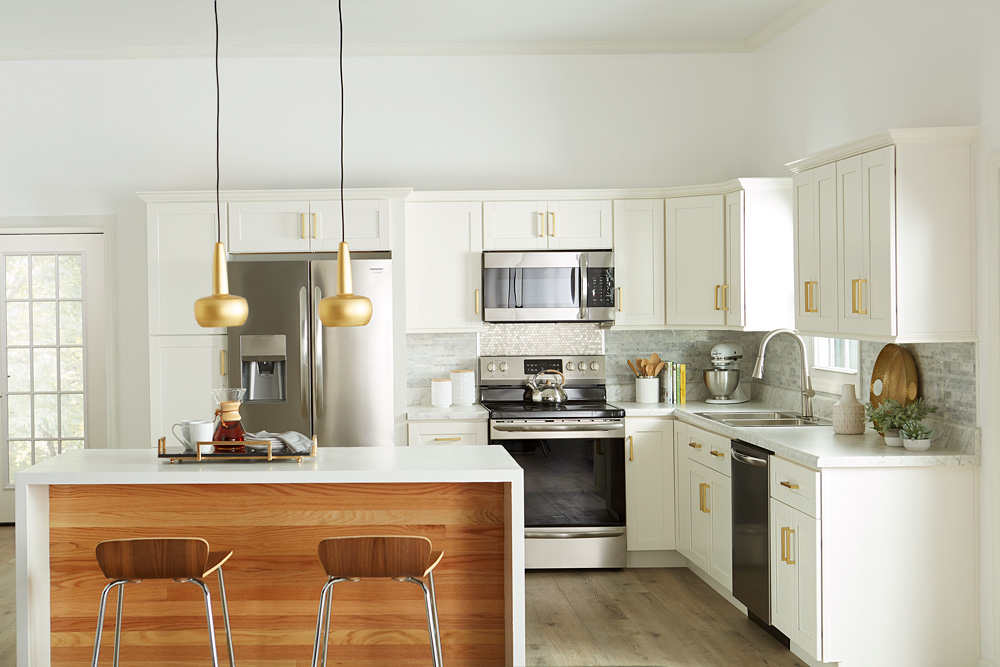
Always remember to refer to our website kilz.com or product back labels for additional information on which primer is right for your project and detailed instructions on how to apply our products.
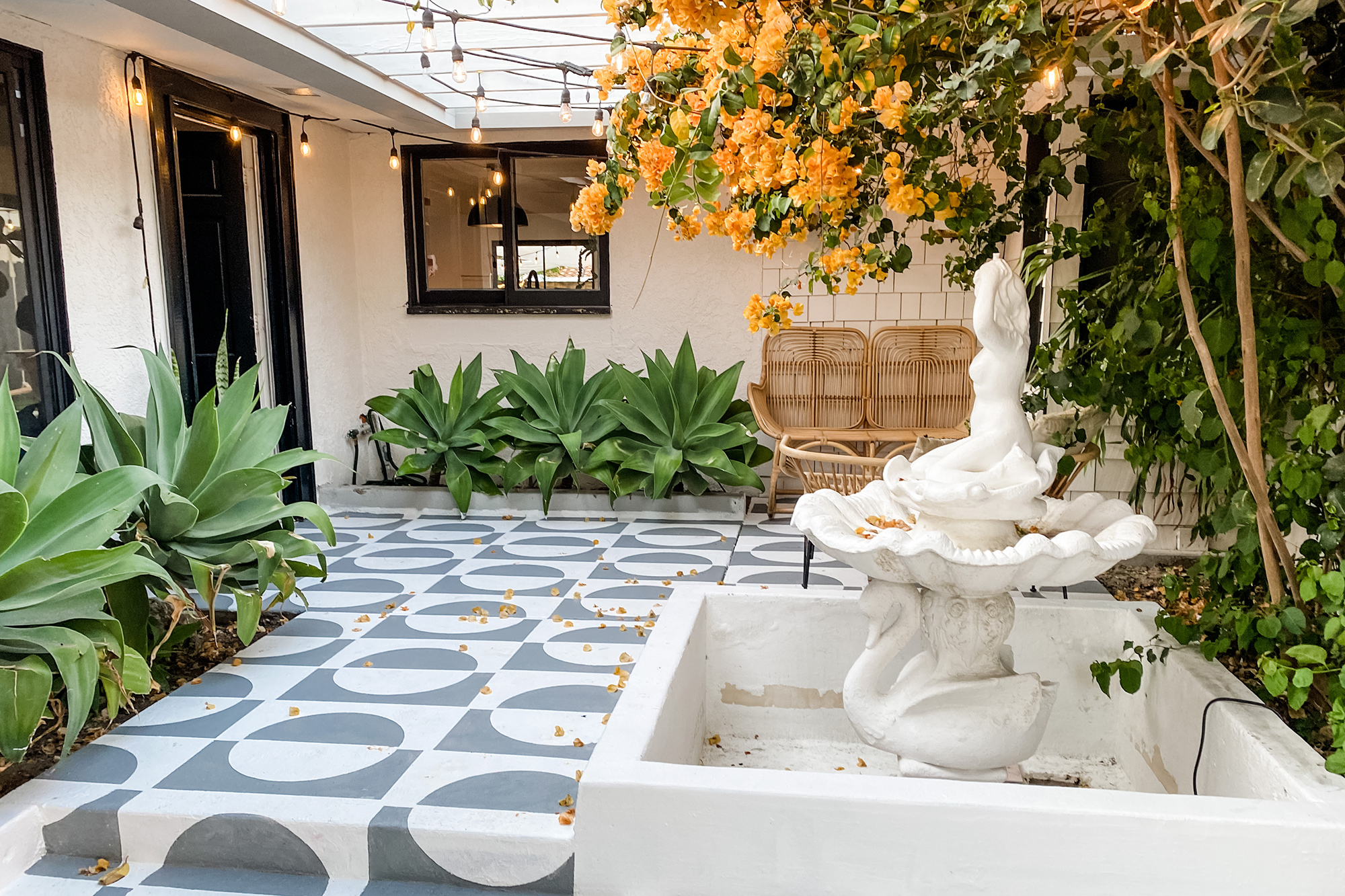
Pro Spotlight: Jesi Haack’s Mid-Century Courtyard Makeover
September 20, 2021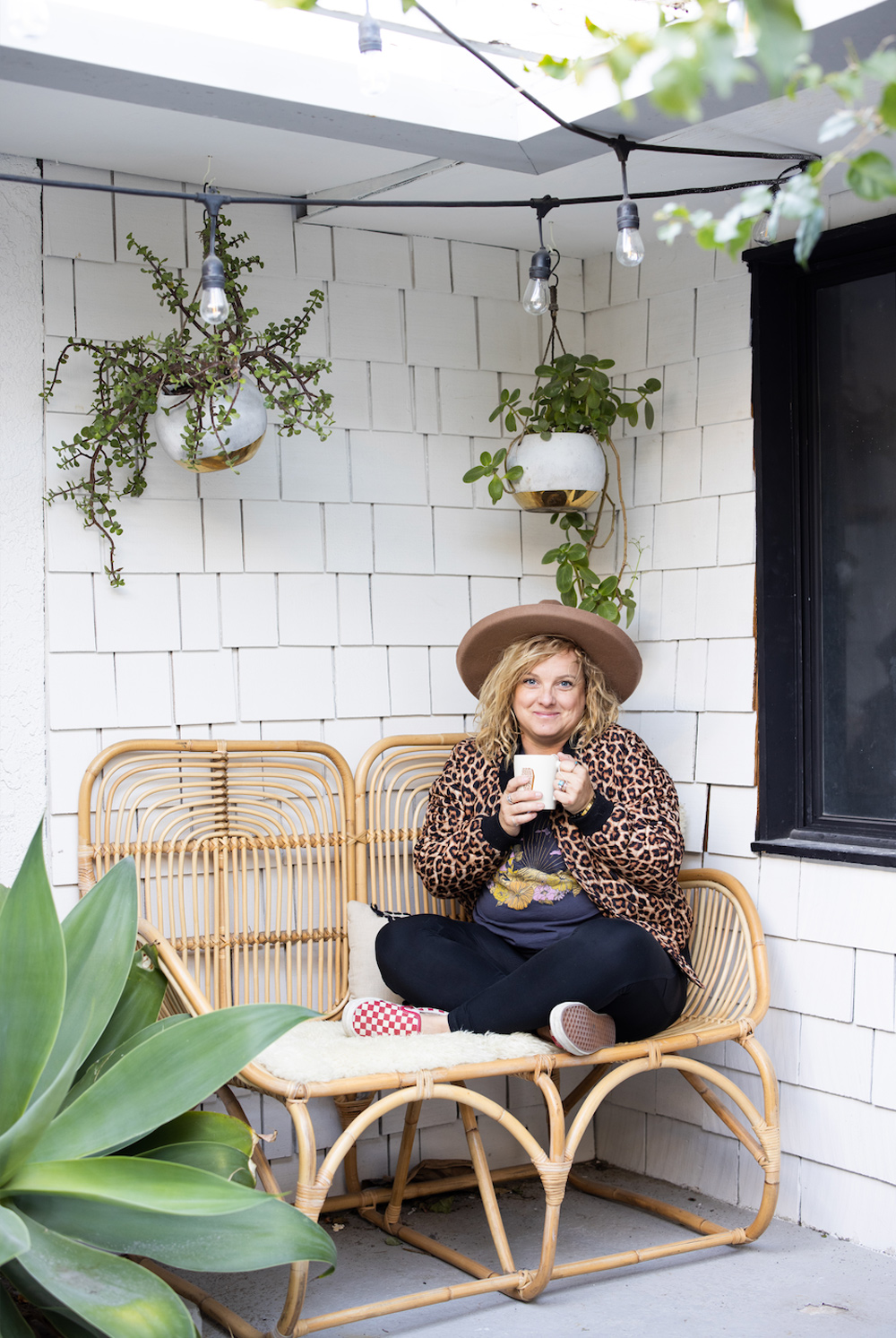 This month on The Perfect Finish, we have an inspiring Q&A to share that includes a stunning stenciled courtyard makeover. A friend of the KILZ team, Jesi Haack is a talented event designer with some serious interior design skills as well. Jesi’s full-service event design company, Jesi Haack Design, transforms traditional events into trendy affairs. She is also the Co-Founder of SLAACK Productions, a corporate event production company specializing in creative & interactive design experiences & installations.
This month on The Perfect Finish, we have an inspiring Q&A to share that includes a stunning stenciled courtyard makeover. A friend of the KILZ team, Jesi Haack is a talented event designer with some serious interior design skills as well. Jesi’s full-service event design company, Jesi Haack Design, transforms traditional events into trendy affairs. She is also the Co-Founder of SLAACK Productions, a corporate event production company specializing in creative & interactive design experiences & installations.
Jesi recently completed a jaw-dropping makeover of her home’s front courtyard, and it inspires some serious DIY envy. Read on to learn more about Jesi and how she completed this gorgeous transformation.
Before we talk about your stunning patio project, we’d love to delve into your DIY/designer background. You own an event design and production agency, and on top of that you’re a super talented DIY-er and interior designer. Tell us how you first got into interior design and DIY’ing and how that led to where you are now.
Well, I’ve always loved making things look cool. Whether it’s for events or in my home. So once Covid hit and turned the lights out on our busy production company, I suddenly had a ton of time on my hands and no creative outlet. Pair that with buying our first fixer home and a huge income hit, I became a DIY’er! Hahaha! I just started figuring stuff out on my own because of boredom, lack of funds and a need for creativity. Once I started sharing my projects on social media, I didn’t anticipate so many people would like what I was doing! And then they started asking me to help with their homes, offices, and projects! It’s been a blast!
Where do you find inspiration for your DIY home improvement projects? Has work for your event design business inspired any of your interior design projects?
I’m inspired by so many different outlets and people. I follow a bunch of different types of builders and creators (I think of them as more than DIY’ers because it truly is an art what they do) and other people’s work is truly an inspiration. And yes! My event installation background is a huge aspect to my work and my style. I try to think outside the normal interior design box and bring in more three-dimensional aspects to interiors. More like art installations that make a big impact. At least that’s where my thought process is.
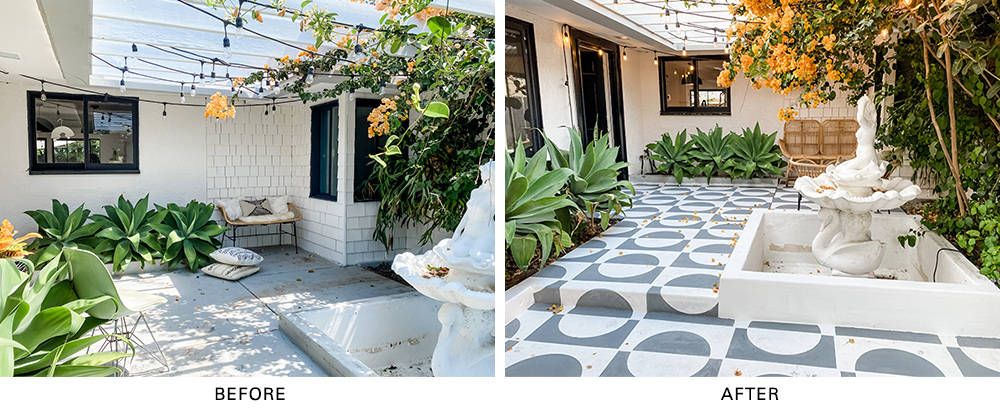
Let’s talk about your recent patio project. What inspired the design and what was the overall process?
I’ve spent a ton of time in Palm Springs for work and am so inspired by the architecture there and the mid-century design style. Our patio was so basic and the concrete so ugly, I knew I wanted to bring it alive with a pattern. I also knew it was an area I didn’t want to play it safe with. I wanted it to make people stop for a sec and notice before entering our home! It was a pretty simple process: clean – prime – stencil – seal!
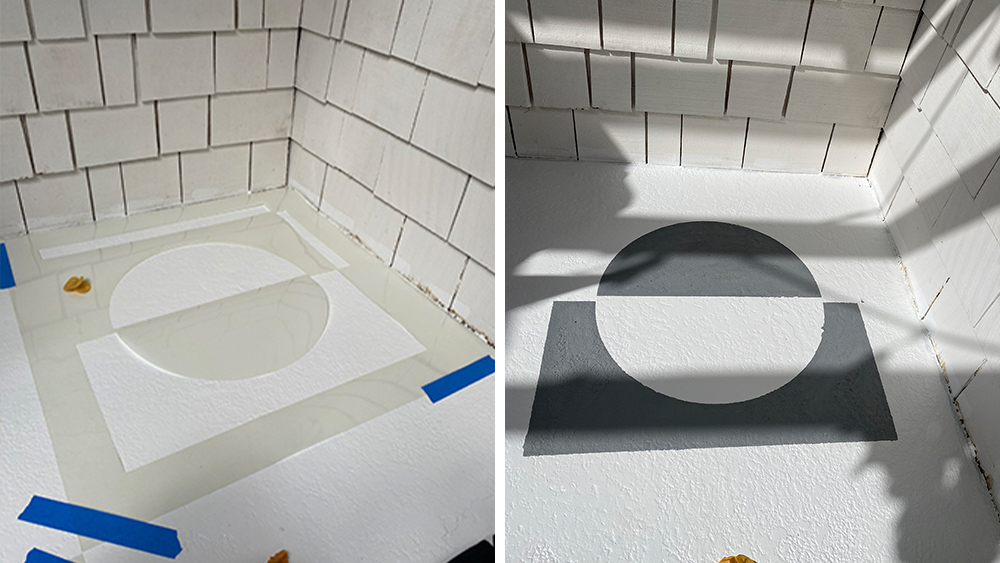
Which KILZ product did you use for the patio makeover and why? How do you think it impacted the project?
I used KILZ 3® Premium Primer and KILZ Over Armor® concrete coating. Kilz primers are my literal go to for any project because they seal the surface I’m working on. For this one in particular, a quality primer was clutch for covering up chipped paint and giving me a blank canvas to use for my stencils.
How did you first learn about KILZ? Have you used KILZ primers for any other projects?
I think my dad told me about Kilz long ago when I started creating. I’ve literally used the primer on everything! My baseboards which got rid of water stains and still have kept them away! Lots of painting projects for our events, the primer helps keep our wood sets from warping in outdoor settings.
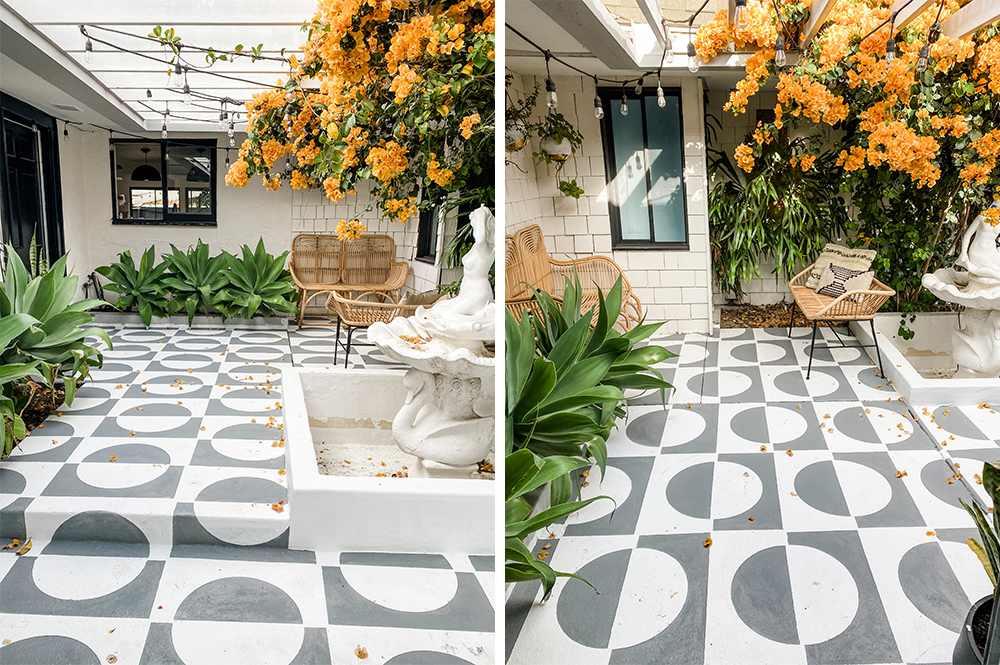
When completing any DIY or interior design project, what are your tips and tricks for success?
A tough lesson I have learned is don’t rush! This is so hard for me. I love diving in and getting to the end result. But don’t skip prepping! Properly taping off and using primer will make your project look more legit in the end and will save you touch up work when all is said and done!
Jesi Haack’s Step-by-Step Directions for a Mid-Century Courtyard Makeover
1. Power wash cement.
2. Use a cement cleaner and pour it on with a plastic watering bucket. Don’t use metal! Scrub with a stiff bristle brush.
3. Let dry completely, typically a day or two.
4. Prime! Use a roller to get a smooth layer. I did 3 coats because I was using Kilz primer as my base coat. Wait a few hours between coats.
5. Map out your pattern with chalk line. (I skipped this step and I regret it). This will ensure each time placement lines up and is straight. Make squares that are the size of your stencil.
6. Time to stencil! Lay stencil down on each square. Use an angled brush to paint on cement paint. I had two stencils so I would alternate so it would give the paint on the stencil a bit of time to dry so it wouldn’t transfer the paint that got on the stencil to the new square. Wash off your stencil every so often to keep your lines nice and clean. Don’t stress too much about lines, you can touch up at the end!
7. Touch up messy lines and spot clean where needed.
8. Let cure for 72 hours.
9. Paint on a cement sealer! Wait 24 hours before using!
Always remember to refer to our website kilz.com or product back labels for additional information on which primer is right for your project and detailed instructions on how to apply our products.
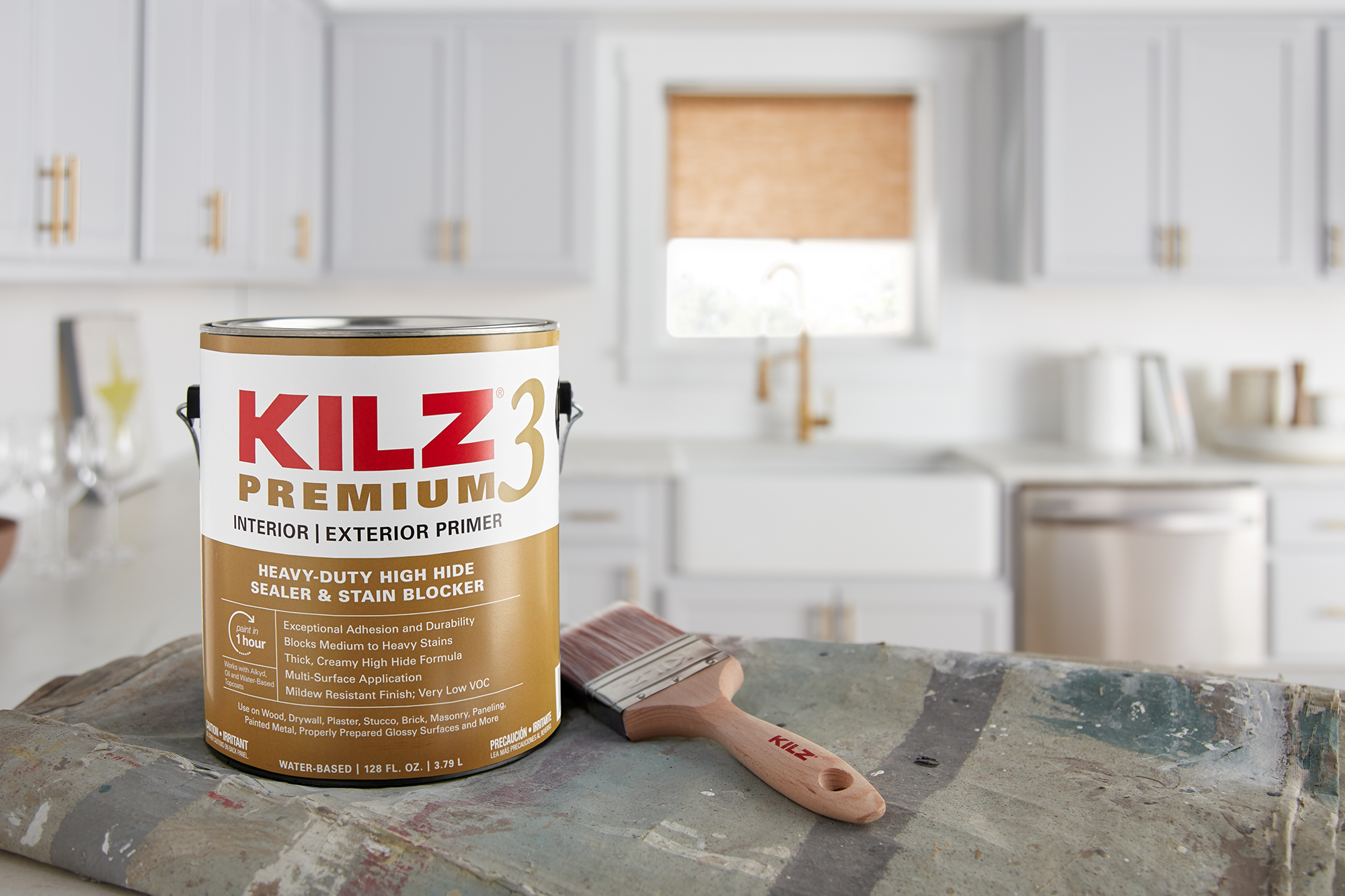
Pro Spotlight: Tom Kraeutler Talks Kitchen Cabinets
August 24, 2021 For this month’s Pro Spotlight, we are excited to share a post authored by Tom Kraeutler – Founder, Host and Chief Home Improvement Evangelist of The Money Pit. He is a hands-on home improvement broadcast journalist and the kind of guy homeowners want to call at midnight when their basement floods. He first earned his home improvement stripes as a professional home inspector, amassing over 20 years’ experience learning how houses are put together, and how they fall apart! Read on to learn Tom’s tips and tricks for one of our favorite projects, refinishing kitchen cabinets.
For this month’s Pro Spotlight, we are excited to share a post authored by Tom Kraeutler – Founder, Host and Chief Home Improvement Evangelist of The Money Pit. He is a hands-on home improvement broadcast journalist and the kind of guy homeowners want to call at midnight when their basement floods. He first earned his home improvement stripes as a professional home inspector, amassing over 20 years’ experience learning how houses are put together, and how they fall apart! Read on to learn Tom’s tips and tricks for one of our favorite projects, refinishing kitchen cabinets.
Refinishing Kitchen Cabinets: Simple Steps to a Colorful Makeover
Author: Tom Kraeutler
Kitchens are perhaps the busiest rooms in any home. Whether it’s meal preparation, homework space, or social gatherings, they serve as the hub of family life. And that means kitchen cabinets must stand up to years of heavy use. A constant cycle of opening and closing wears out their finish, pots and pans scratch them, and hinges and handles wear out. But while replacing kitchen cabinets can be a time-consuming, expensive, and difficult task, refinishing kitchen cabinets is not and can deliver stunningly colorful results.
Here’s what you need to know to get this project done.
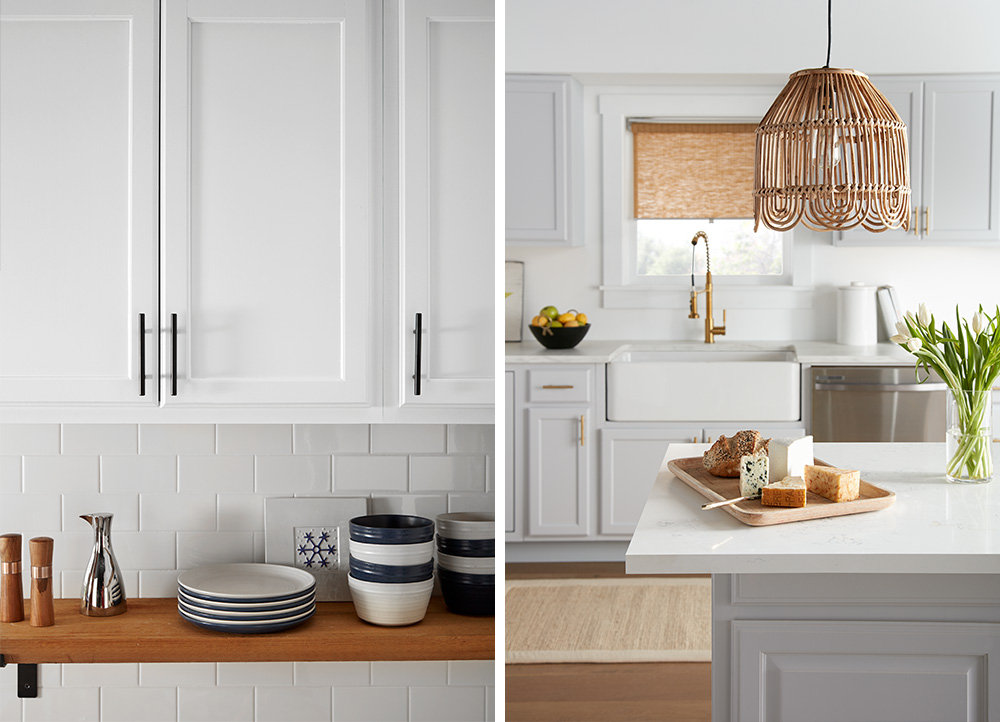
Getting Ready: Prep Makes Perfect!
My earliest DIY inspiration came from my father who always said the “gettin’ ready” was the most important part of the project! Years later and no longer an impetuous teenager just looking to get my chores done quickly, I realized how right he was. Before popping the lid of the paint can, set yourself up for success by getting the space and cabinets ready.
First, clear out furniture and clean out the cabinets from top to bottom. Then, remove all the cabinet doors, shelves, and drawers, and take off the hardware.
Tip: Label the doors and drawers in an inconspicuous area so you’ll know where they belong when the project is complete. For drawers, mark the bottoms. For cabinet doors, the area behind the hinge works well.
Next, cabinet finishes can be magnets for dirt, dust and grease so wash them thoroughly with a solution of TSP (trisodium phosphate). Be sure to clean the top of the cabinets as well, as dust that gathers here can float down and stick to the finish as it dries.
Evaluate the cabinet surfaces. Applying a new finish on top of an old finish that’s not adhered to the original surface is a recipe for disaster. Any loose, chalking or cracked paint surfaces should be scraped smooth. For most surfaces, and especially those that are glossy, a light sanding will help improve adhesion between the old surface and the primer.
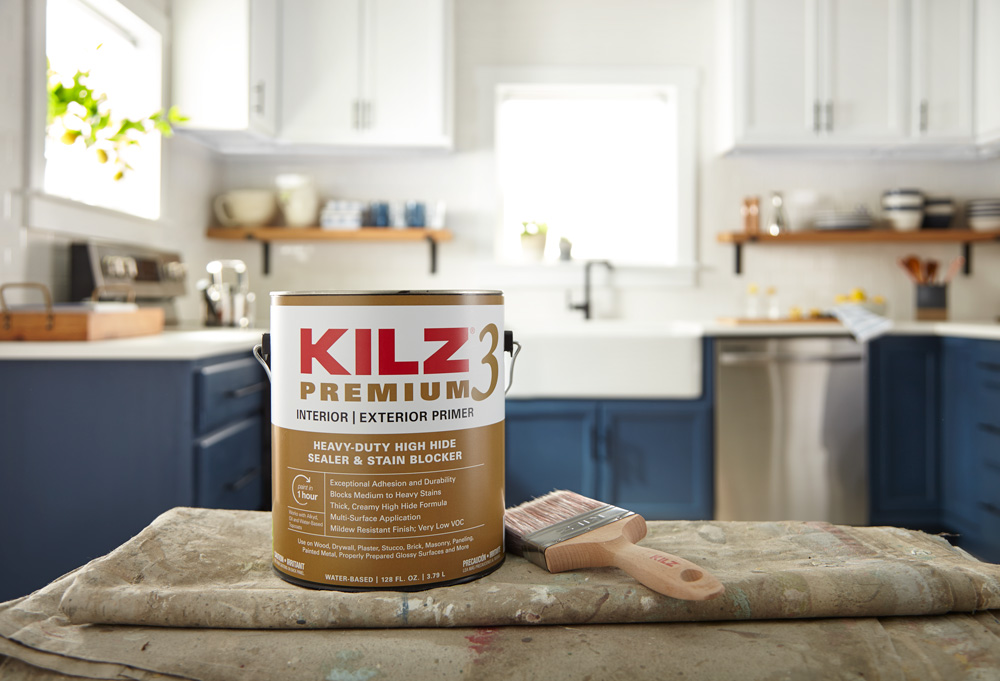
Primer Selection Drives Durability
Selecting the right primer for kitchen cabinet refinishing is critical. The primer helps assure the top-coat of paint adheres to the cabinet, provides durability and helps assure the final finish flows evenly with minimal brush strokes or roller marks.
KILZ 3® PREMIUM Primer is an excellent choice for this part of the project. The primer provides exceptional adhesion with a mildew-resistant finish, making it ideal for projects in moisture prone areas such as kitchens and bathrooms. I also like that KILZ 3 is what’s known as a “high build” finish. This means that it can fill in minor imperfections in a cabinet surface or minimize deep wood grain patterns when painting oak cabinets, for example. KILZ 3 is also water-based for easy clean-up, dries quickly, and has a low-odor, low-VOC finish.
KILZ 3 should be applied evenly using a brush, roller, or airless sprayer, as specified by the manufacturer. Only a single coat is needed. Set up a space to layout the doors and drawers for priming, and then prime the cabinets working from the top-down.
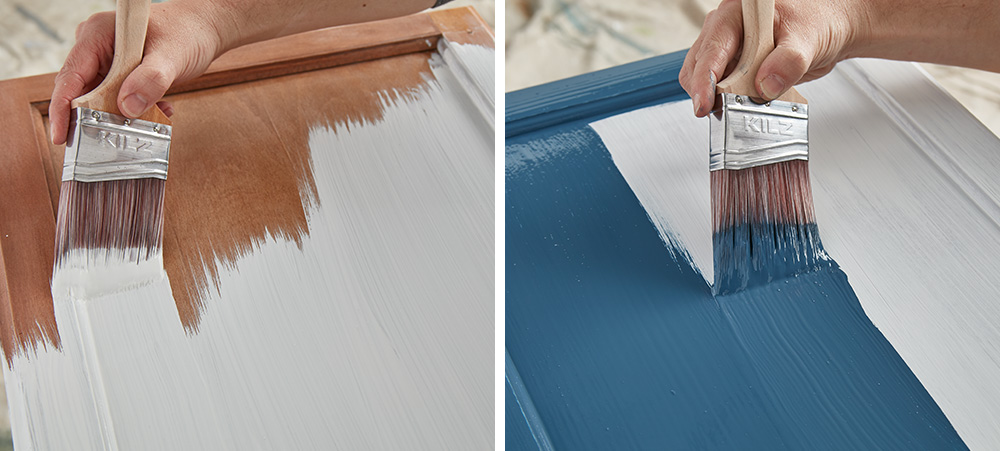
Top-Coat Counts
Just like primer selection is based on the product’s adhesion, moisture resistance and high-build formulation, equal care should be given to the selection of paint for the top coat. Over the course of your newly painted cabinet’s life cycle, doors and drawers will be opened and closed thousands of times. Moisture in the air will be a constant presence, as will oils and grease given off by years of cooking. Therefore, you’ll want to select a paint that has excellent durability and is very easy to clean.
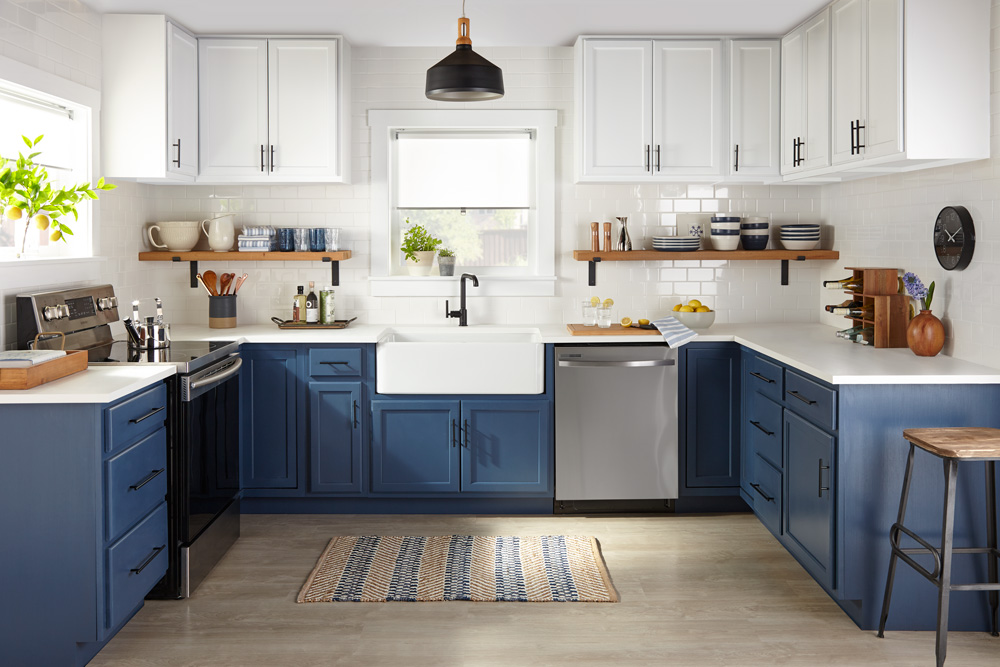
Look for paints made specifically for kitchen cabinets. Magnolia Home by Joanna Gaines® Trim, Door + Cabinetry Paint dries quickly, leaving a hard finish that’s remarkably durable and it is water-based for easy cleanup. For most projects, plan to apply two-coats and follow the manufacturer’s directions for application.
Add Some Bling
Once the painting is complete, you’ll have the option to replace the original hardware or add new. Given the work it’s taken to get to this point in your kitchen cabinet refinishing project, installing new door and drawer pulls adds some bling and provides a nice finishing touch.
This part of the project is easiest if the new hardware fits the holes left by the original hardware. However, if you plan to go in a completely new direction, it’s easy enough to fill and sand the old holes before you get to the priming step above. Personally, I also like to replace the hinges as well. New spring-loaded hinges look good and close nicely. Finally, install bumpers to the drawers and doors for added durability.
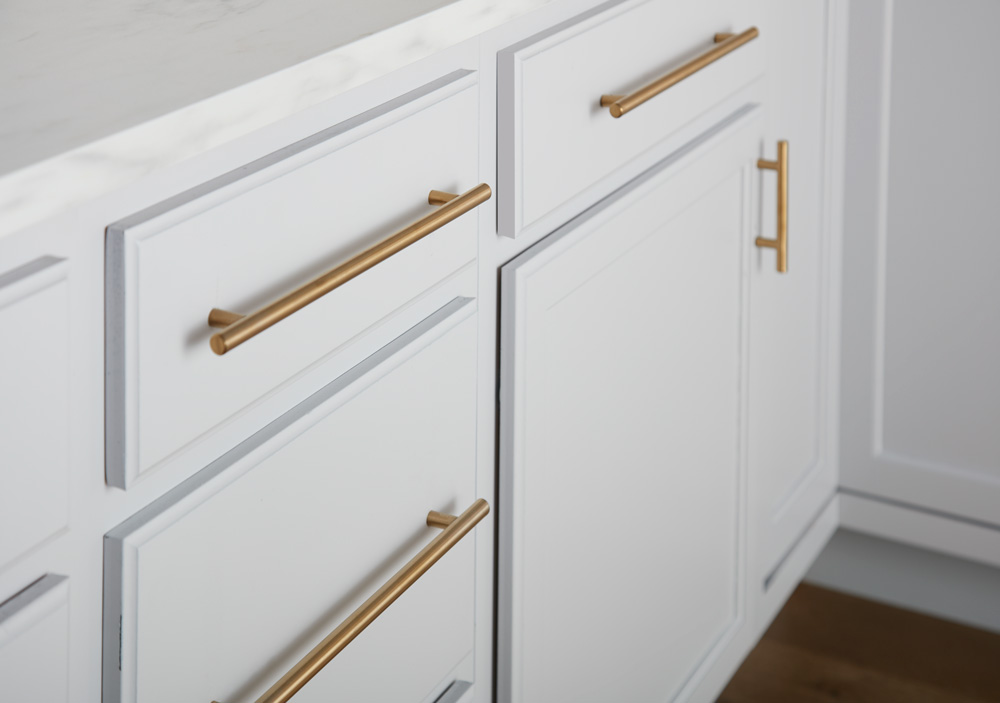
Today, solid-color kitchen cabinets are more popular than ever making this an ideal time to take on a kitchen cabinet refinishing project. But the success of refinishing kitchen cabinets depends entirely on the details. With the right prep work, a high-quality primer, and a colorful, durable top coat, you can transform this space with a fresh finish that can last for years to come.
Always remember to refer to our website kilz.com or product back labels for additional information on which primer is right for your project and detailed instructions on how to apply our products.
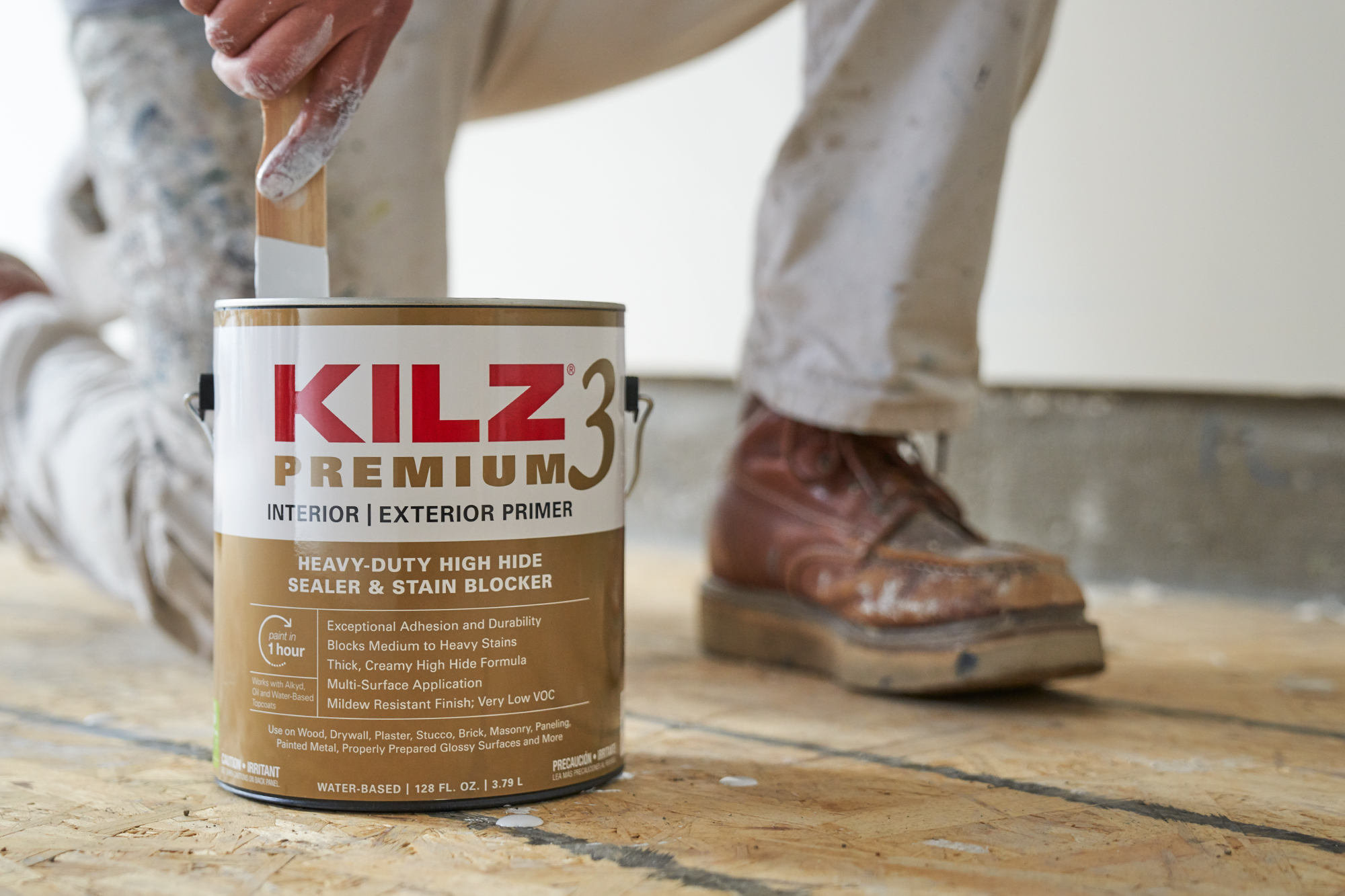
Ask the Pro: Primer Makes a Paint Job Better
April 19, 2021
It’s no secret that here on The Perfect Finish we’re advocates of proper prep work, and for us that conversation always includes priming before you paint. Primer can do a lot for your paint job, and the professionals know it’s worth the extra step.
To share all the reasons why and how primer makes your paint job better, and answer some often asked primer questions, we brought back Product Manager John Golamco. He’s been on the KILZ team for over six years and has a wealth of primer knowledge. Ready to learn more? Let’s get rolling!
Is primer only necessary when your paint does not have primer in it?
Applying primer is an essential prep step when you apply paint or a topcoat coating. As such, it is important to apply primer first and then (once it’s dry) apply the topcoat/paint over the primer coat. Primer is engineered differently from paint – primer has more resin/binder in the formula, which is the “sticky stuff” that helps with adhesion and other additives that give the primer its ability to solve a variety of problems. Paint, on the other hand, has more pigment in the formula in order to deliver color.
How does primer make my paint job more durable and long-lasting?
Primer helps the paint or topcoat stick to the surface better and prevent problems like peeling and cracking – ensuring the topcoat lasts longer on the surface. Depending on the type of primer (there are several types), it can solve a variety of surface related conditions and problems that could ruin your topcoat paint if you didn’t apply primer first. Primers can evenly and uniformly seal porous surfaces; hide previous colors or marks and stains; block and seal in bleeding stains (like tannin, grease, nicotine, water stains… just to name a few!); seal in unwanted odors; enhance adhesion and help bond the paint/topcoat to the surface; and prevent mold or mildew on the primer film surface, and other special features. There are even primers formulated for different spaces in the home, like KILZ Kitchen & Bath Primer.
How many coats of primer do I need?
Typically, you only have to apply one or two coats of primer to achieve optimal results for which it is intended. One common misconception is that you need to continue to apply coats of primer until you completely cover the surface in a white finish or hide every area possible like you would do a paint. It is not the primers job to provide the final complete paint finish – that’s the paint’s job. Even if it doesn’t look completely covered, one or two coats is all you need as long as it is evenly applied. For blocking water stains or tannin from a “fresh” red wood surface, more premium stain blocking primer is recommended.
Does primer work on all previous paint sheens?
Just like most things you can buy, there are different types of primers ranging from the simpler ones that are made to just seal porous surfaces to the more sophisticated ones that offer additional features and benefits. Typically, the higher performing, more premium primers have better adhesion performance that allows it to stick to more surface types. Typically, the denser/harder the surface and the more sheen (higher gloss), the more difficult it is for paint or primer to adhere to. We recommend using high adhesion bonding primers for dense, glossy surfaces. Sometimes it is also necessary to perform a light sanding of the surface to help the primer bond to it. A high-performance primer such as KILZ 3® Premium Primer or KILZ® Restoration Primer will work with most paint sheens.
Can I apply primer on wallpaper?
When it comes to painting over old wallpaper, the best practice is to remove it completely, remove any old wallpaper glue and dirt residue, ensure the surface is clean and smooth and then apply primer and then topcoat with new paint. However, if painting over old wallpaper is needed, we recommend ensuring the old wallpaper is not peeling and adhesion to the wall is still sound. Then use an oil base primer such as KILZ® Original Primer to prime the surface before applying paint. Using an oil base primer will make sure there is less chance the adhesive of the wallpaper (which may be exposed at the seams) is compromised.
Is there a primer with a clear finish?
Most primers will adhere to wood however there are special primers that will apply in a clear transparent finish. We recommend KILZ KLEAR® Clear Sealer & Bonding Primer – a high performance fast-drying, multi-surface clear primer developed to seal highly porous surfaces inside and outside your home. It is also recommended for use when painting the same topcoat paint color on top of an existing paint coat.
Can primer be applied to peeling paint?
Applying primer or any additional topcoat coating to already peeling paint is not recommended. The adhesion or bonding of the paint to the surface is already compromised. Adding more layers of primer or any coating will add weight to the compromised paint and might cause it to peel off completely. We recommend removing the peeling paint and starting fresh with a clean surface.
Always remember to refer to our website kilz.com or product back labels for additional information on which primer is right for your project and detailed instructions on how to apply our products.
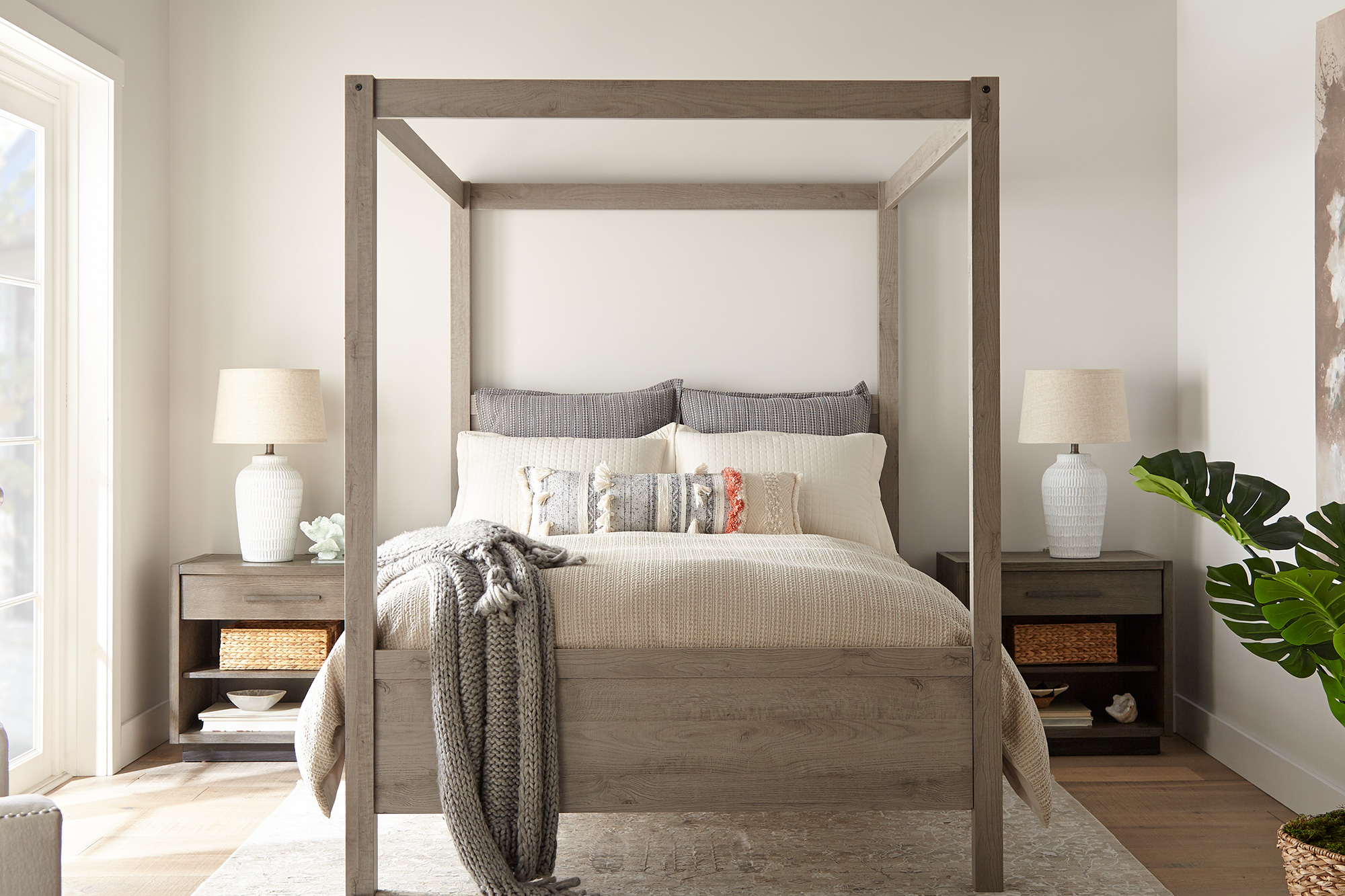
Transforming a Boring Bedroom into a Relaxing Oasis
April 8, 2021Nothing dulls the spirits more than a boring, dated bedroom design. That’s why we couldn’t wait to lift the spirits of this depressing bedroom with new colors and textures to make it sparkle with freshness.
Color has a huge impact on mood and energy levels; and especially given the stresses of the past year, it’s more important than ever to promote a healthful, stress-free atmosphere in all areas of your home — and most particularly, your bedroom. That’s why we chose creamy off-white colors that create a soothing atmosphere of calm and relaxation, while opening up the space visually so it doesn’t feel as stuffy and confined.

We began our project with the most valuable tools for any DIY makeover — primer and a coat of paint. For this makeover, we chose KILZ 3® Premium Primer, which did an amazing job of covering the old, drab olive-green paint and creating the perfect foundation for the new fresh white paint. KILZ 3 Premium Primer offers excellent adhesion and durability, allowing the new paint to glide on smoothly and adding to the longevity of your paint job.
Next, we added a coat of KILZ® Tribute® Paint in Collector’s White (TB-31). This is a creamy, barely-there white with subtle undertones of greige (gray/beige) to take the brightness down a notch, making it ideal for reflecting the sunlight filtering in from the glass doors in this master bedroom. Because of its cool undertones, we were able to use Collector’s White throughout the entire bedroom, creating a soothing, gently glimmering sparkle without a hint of harshness.
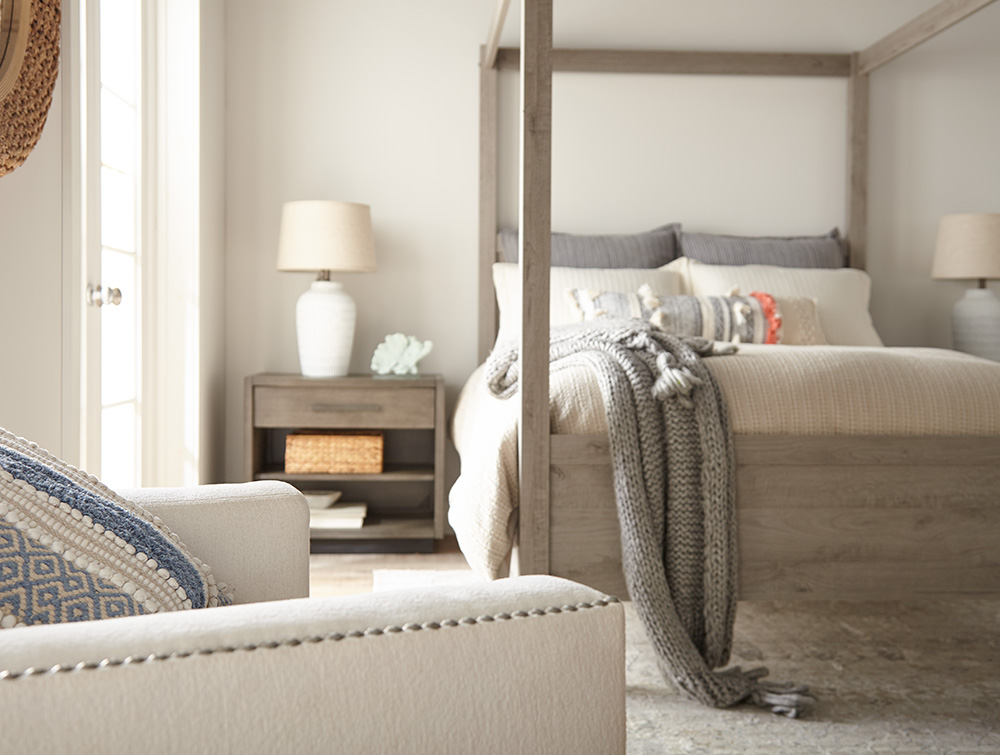
Our keynotes for this makeover were airy, simple, calm and relaxing, and we accomplished these with a streamlined Contemporary Swedish-Meets-Coastal California theme. For the focal point, we chose a modern four-poster bed in gray-toned brown natural wood. We added matching lacquered wood bedtables in a similar brown/gray shade, styled in keeping with our Scandinavian/Danish Modern theme.
We kept the attractive, natural hardwood floor, but added a cozy off-white rug. Other furnishings and accessories — including an armchair, lamps and bedding — were chosen to reflect the creamy white of the walls.
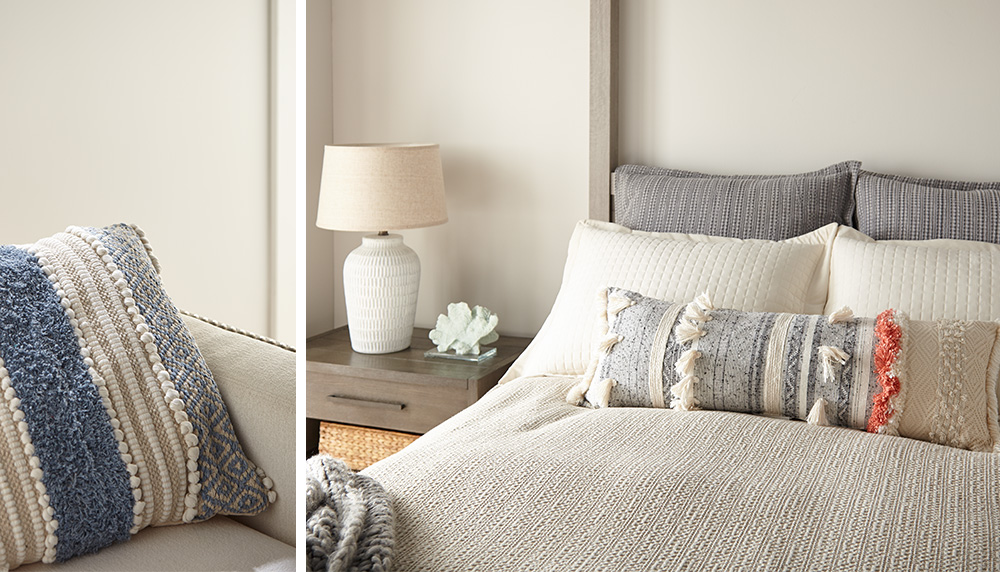
One interior designer’s tip: Pillows and other textiles are a great, affordable way to underscore your design scheme. We choose plump, oversized woven natural-fiber pillows in shades to tone in with the rest of the room, with handcrafted touches such as pom-poms and fringe. We finished the look with two attractive white ceramic lamps, styled in the Danish Modern tradition and topped with pale ecru linen shades.
The overall look is one of natural textures — crisp linens and woven cottons — giving this master bedroom a clean, fresh, inviting look of soothing freshness. When coupled with the bright sunlight filtering in from the glass doors, the impression is of a gleaming, glistening oasis for rest and relaxation — the kind of ambience you would look for in a luxury spa or hotel. And with quality primer and paint, the good news is that this pristine, fresh clean look can be easy to maintain as well.
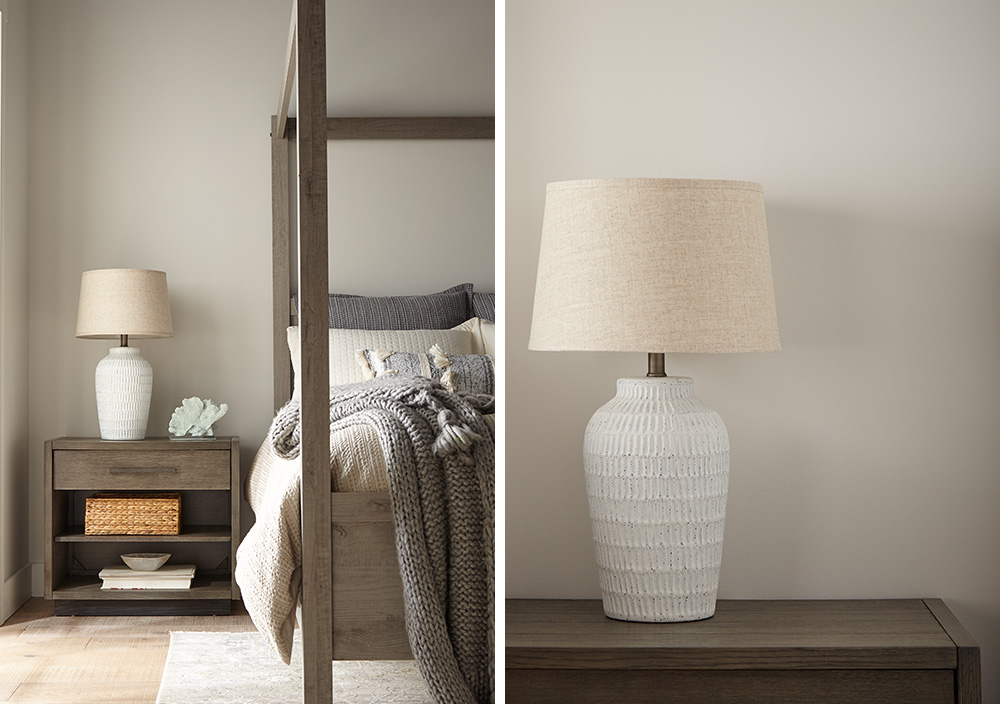
Anyone can achieve a room transformation like this at an affordable price. The key is to choose colors that reflect the mood and ambience you want to create — whether it’s light and airy or warm and nostalgic. That’s why paint and primer are your greatest tools in any DIY makeover. They’re not only affordable, but they’re also so easy to apply that even a newbie can do it without any help, and with spectacular results.
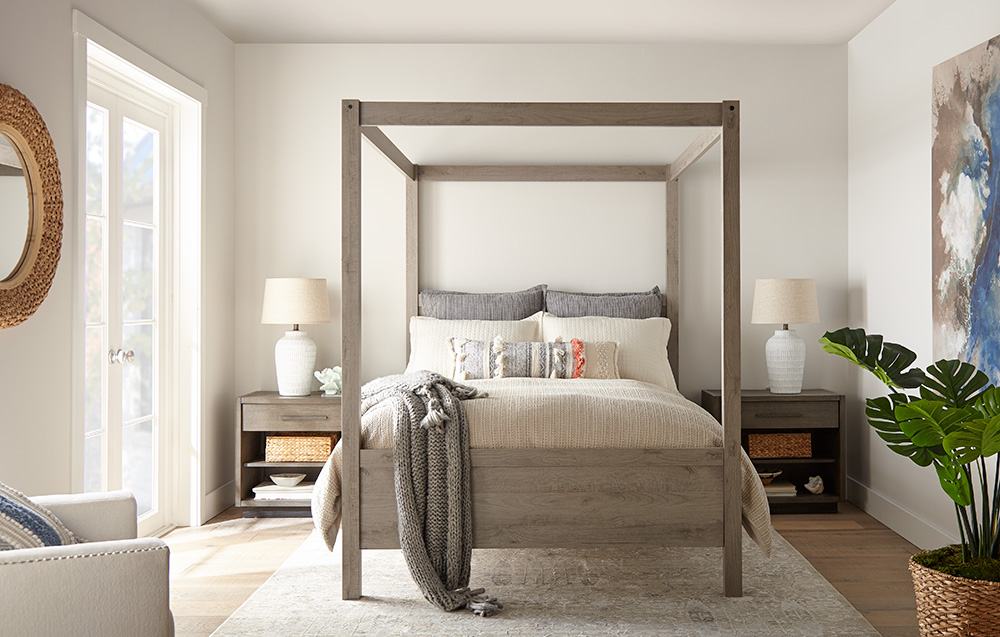
With primer and a coat of paint, you can transform a dull, outdated room into a showplace. The primer will enhance all your painted surfaces, while protecting them from household dust, dirt and mildew. Likewise, a fresh coat of paint will lift a room into a new dimension of beauty and vibrancy. Just add a few pieces of furniture and accessories within your budget — and voila! You’ve created an affordable, elegant room makeover that will stimulate your sense of color and beauty, while relaxing your mind and spirits.
Always remember to refer to our website kilz.com or product back labels for additional information on which primer is right for your project and detailed instructions on how to apply our products.
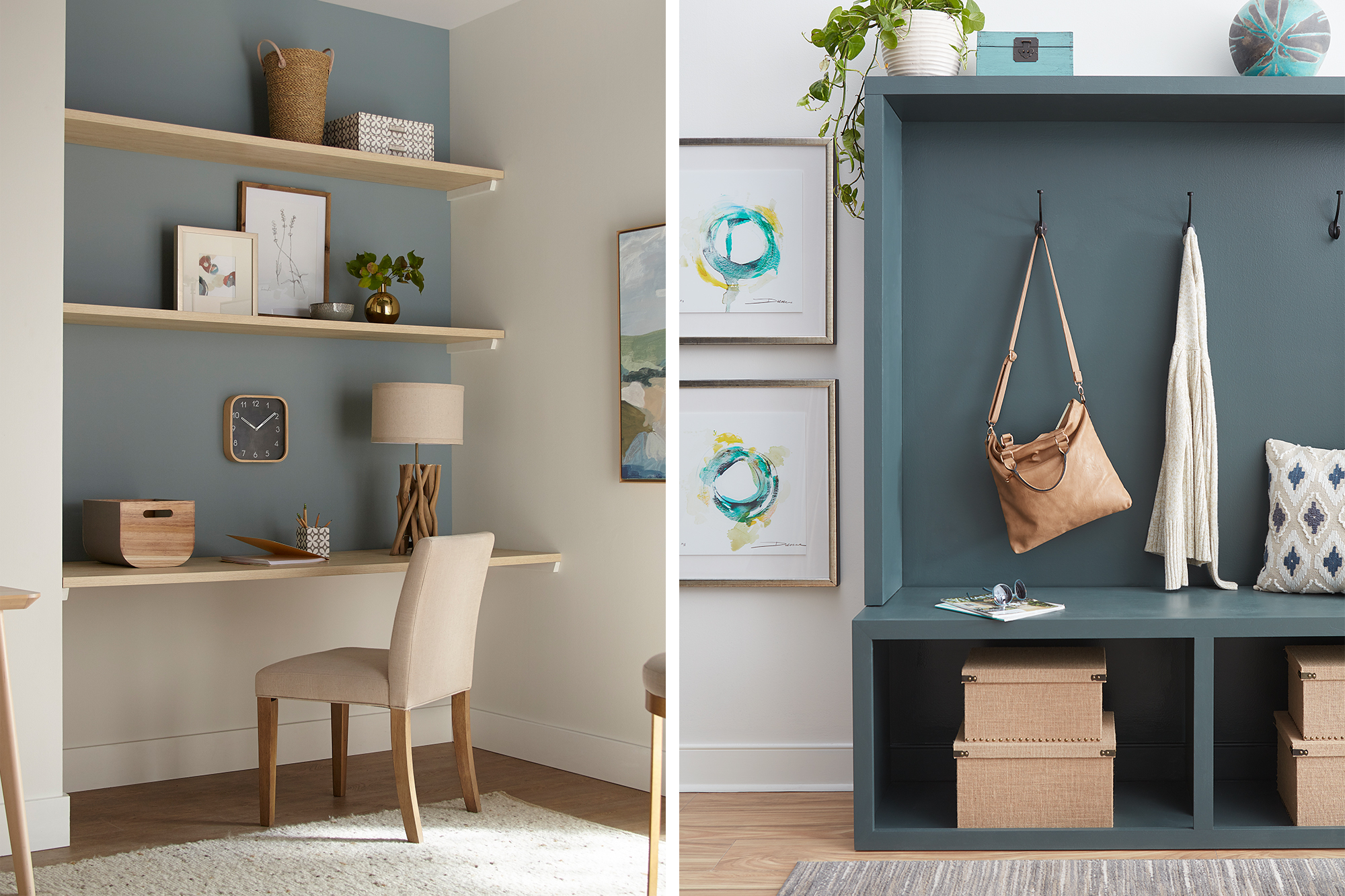
Creative Ways to Carve Out Functional Spaces
March 23, 2021The home office is becoming as standard as the laundry room. With more people working from home than ever before, often alongside children who are distance learning, people have been forced to get creative with their living/working/study spaces. Rather than trading in your dining table for a desk, try one of these ideas that empower multifunctional spaces and add some design flair to your home at the same time.
Here’s how you can fit everything in your life comfortably into your home.
Carving Out Office Nooks
The “corner office” has taken on new meaning. If you feel like your office is quite literally crammed into the first corner made available in your home, it’s time to take a look around and see if you can give yourself an upgrade.
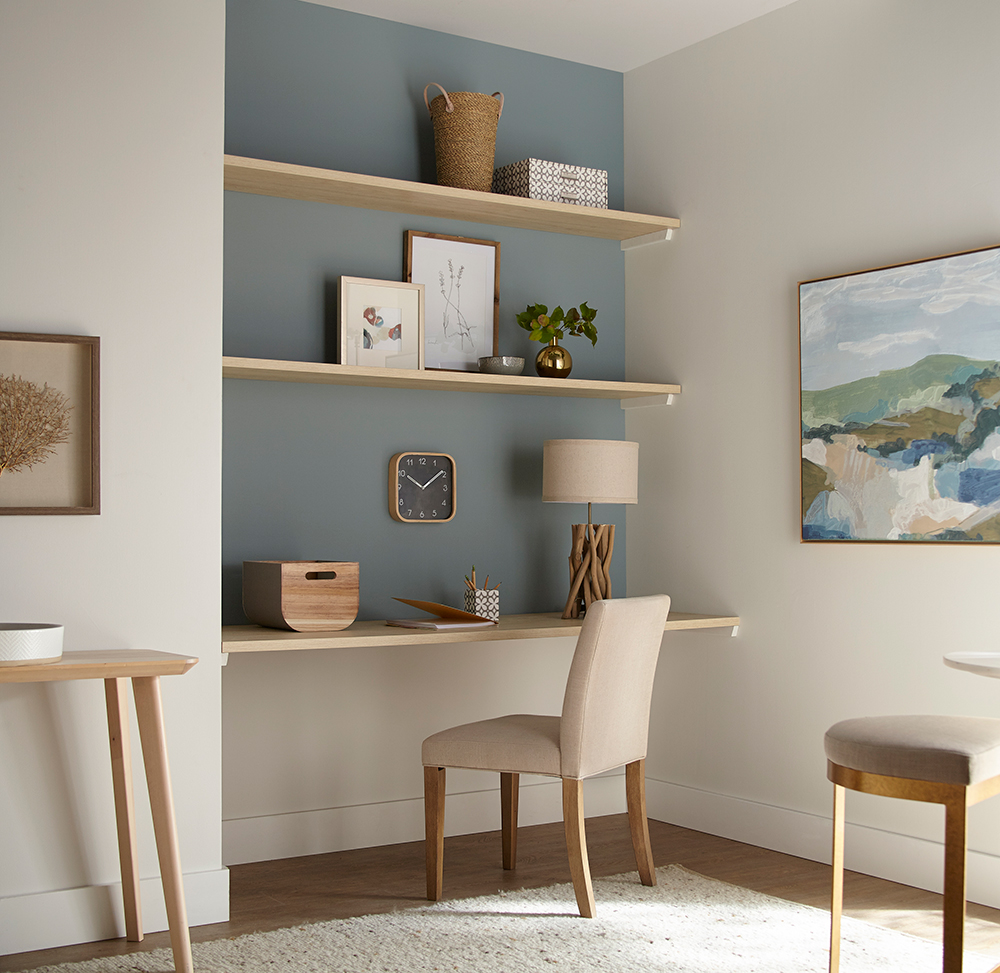
For some households, having a workspace in the main living area isn’t a big deal — especially if you have a laptop that you can easily fold away to make room for other things when work is over. However, if you need more room to spread, out or you just work better at an actual desk, there are creative ways to fit it in and make it look great. Take this small-space office nook for example – with KILZ 2® All-Purpose Primer, a fresh coat of paint and built-in shelves, we converted a neglected nook into a pretty WFH space. See the full transformation here.
Building in Organization
Building organization into your house is essential for reducing all clutter that inevitably comes with spending more time at home. When things have a place at the end of each day, they’ll be out of your way. You might decide to relocate things around the house as you find new storage spaces, whether it’s under-the-bed, behind the couch, on top of the kitchen cabinets, or in the hall closet. The key to avoiding the look and feel of clutter is to have some rhyme and reason behind what you put where.
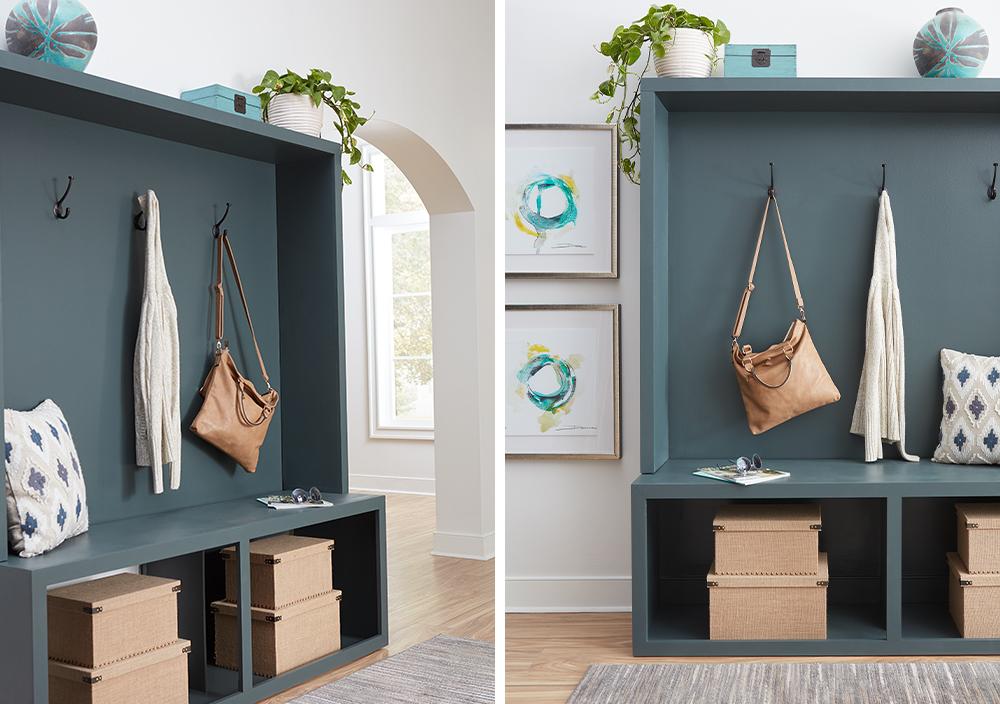
Adding some storage to your entryway or mudroom is a practical (and pretty!) way to keep the mess at bay. For this entryway storage center, KILZ Primer was the essential first step in transforming a boring wood bench into a statement piece. After priming the bare wood with KILZ 2® All-Purpose Primer, a fresh coat of pretty gray-green paint (KILZ Tribute® in Typewriter TB-70), completed the look.
Pretty baskets and bins, like the boxes in our entryway project, keep things aesthetically pleasing. Consider going the extra mile with labels to help everything find its way back to its rightful place.
Visually Divide Multipurpose Spaces
If you’ve found yourself using words like “multifunctional” more than you ever thought you would, you’re not alone. Putting up walls and partitions may be infeasible and is less than preferable. So, when it comes to squeezing more living (and working) out of the living space you already have, there’s a trick: divide them visually instead of physically.
One of the best tricks to keep things pleasing to the eye and mentally in their place is to visually divide your spaces with the use of intentionally placed paint colors. These can be in the form of a full accent wall or a smaller arch or geometric design. The visual definition from a pop of color helps you define a space a within a space.
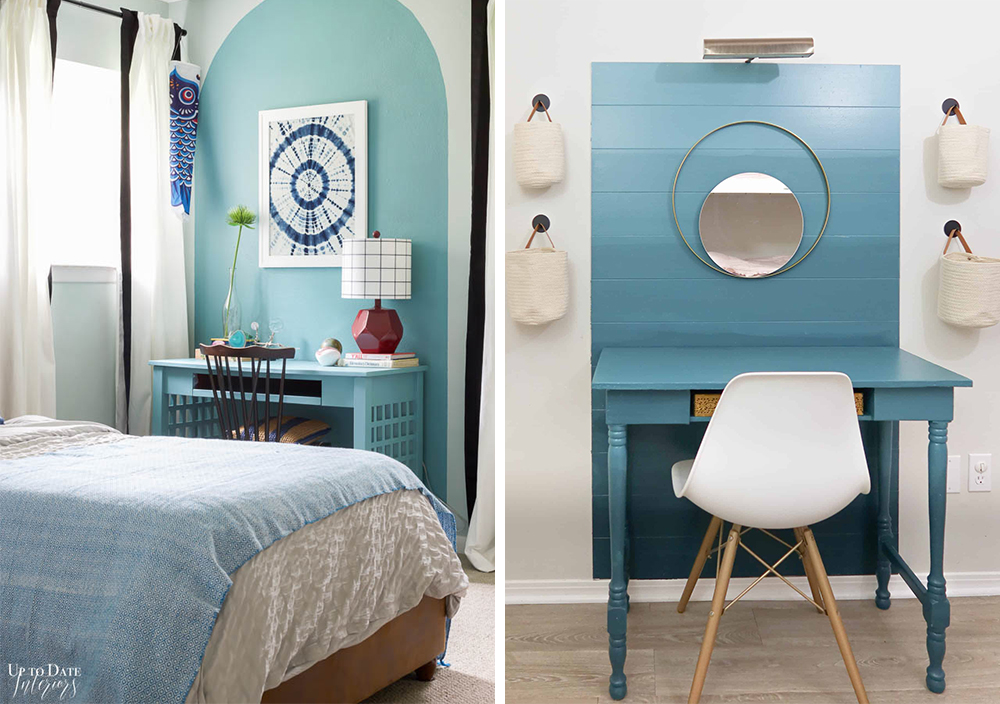
We’ve partnered with a few design savvy influencers in recent months who used primer and a coat of paint used to define their workspaces, and they are sure to inspire. Kathryn, from the blog Up to Date Interiors, used KILZ 2® All-Purpose Primer and KILZ® Paint to create a soothing blue arch behind her desk. Another fun and functional workspace came from Lindsey at Repurpose and UpCycle. Her ombre accent wall/desk combo came to life with the help of KILZ 3® Premium Primer and KILZ® Paint.
These visual dividers are pleasing to the eye and can even make your home feel larger when done right. Plus, it’s something you can do yourself. With primer and a coat of paint, KILZ can help you get more out of your home and make use of the space you already have.
Always remember to refer to our website kilz.com or product back labels for additional information on which primer is right for your project and detailed instructions on how to apply our products.
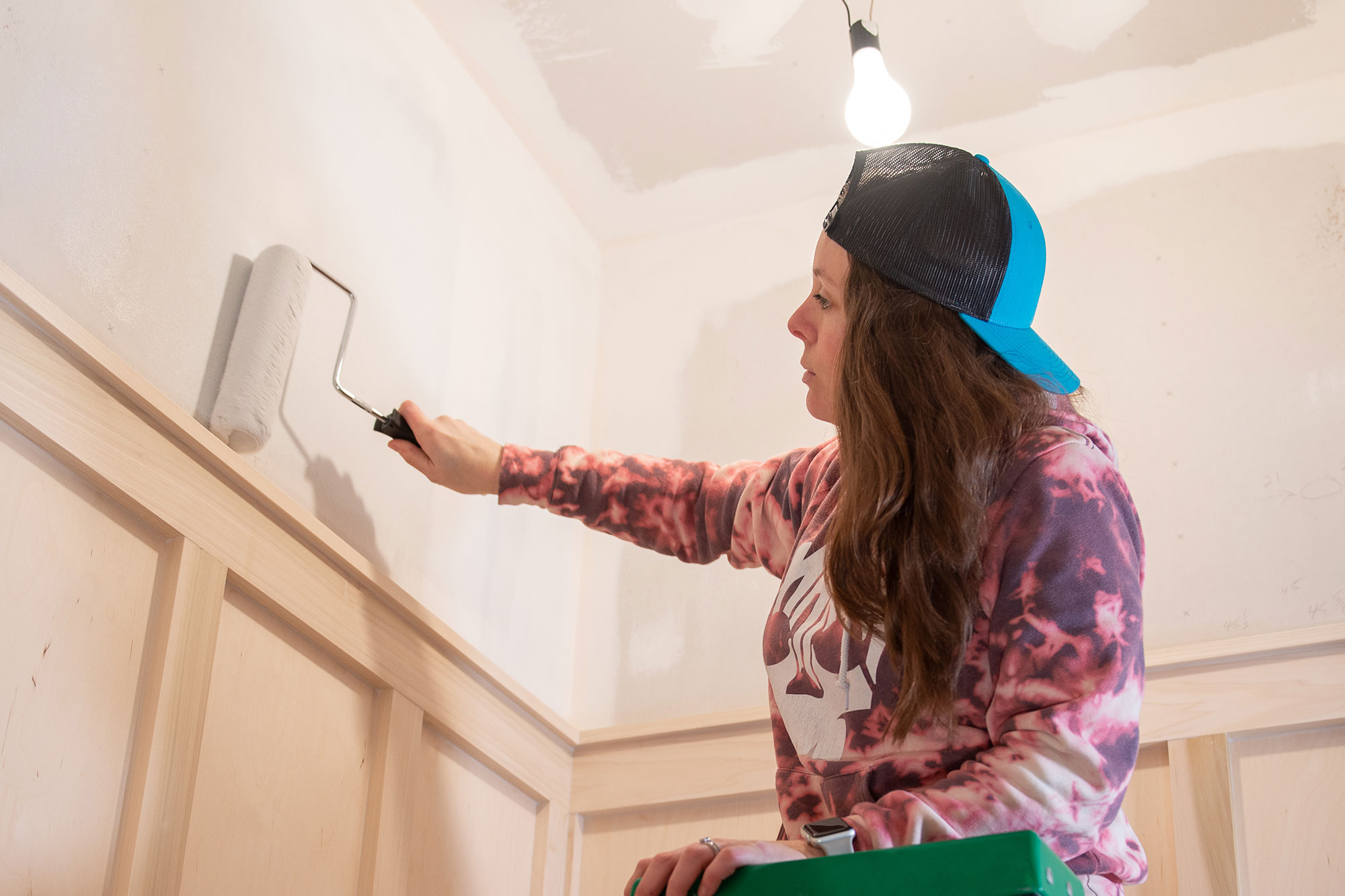
Pro Spotlight: A Well Made Mudroom
March 23, 2021Today on The Perfect Finish we’re excited to spotlight Christy from Oak Hill Millworks. She is an all-around design and DIY pro, with exceptional skill in woodworking. KILZ® Primer was key in her incredible mudroom renovation project, read on to learn more!
Did you know that a well-made mudroom can change your mindset? – Christy, Oak Hill Millworks
Hey there! I’m Christy, owner of Oak Hill Millworks, a creative venture based in the greater Pittsburgh area that aims to educate, entertain, & empower. Most of the topics I focus on have to do with woodworking & DIY, which is why we’re here! I want to share with you how I used tried & true KILZ primer to help drive my recent mudroom remodel home. KILZ is a brand that I have used since I can remember. My grandfather was a cabinet maker and he himself endorsed KILZ brand primer. It’s just one of those brands you can rely on, you know what I mean? And honestly… with how problematic life has been over the past year with so many unknowns, using KILZ is a simple solution in my mind.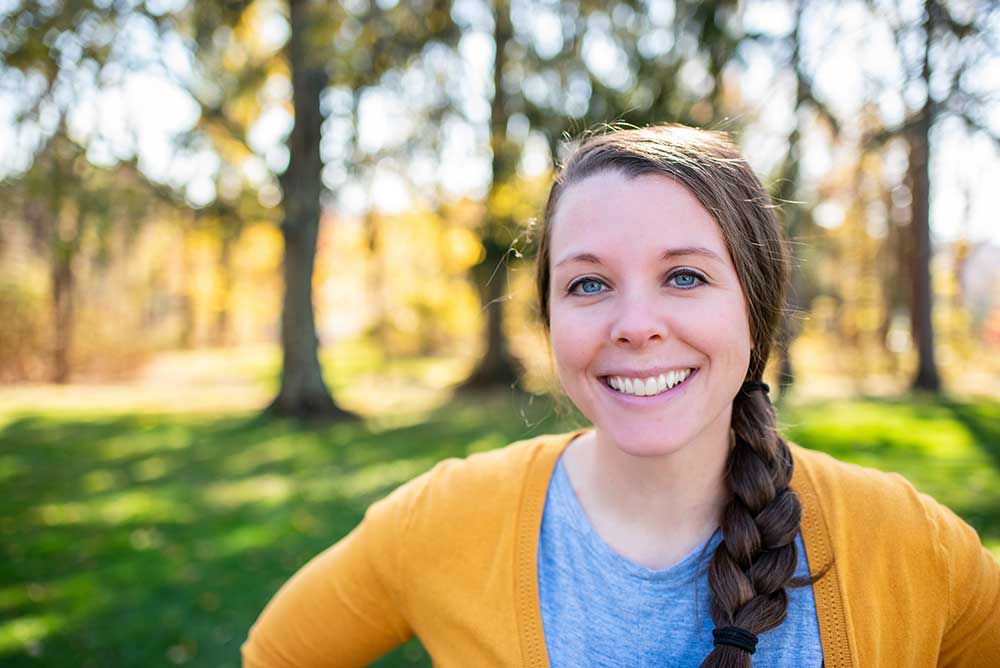
Speaking of problems, my old mudroom and I did NOT get along. It was all function and no form. It still had plaster and wood lath from the 1950’s – I knew it was going to require brand new drywall and some new built-ins for me to be really happy with the remodel. I knew I would have some unknowns to contend with because remodeling an older home can come with surprises like unlevel floors, out of square walls, and insufficient wiring. When KILZ offered to help out by sending me their primer & paint, I knew I was in good hands because like I said, with so many unknowns, it’s reassuring to have something you can depend on.
Day 1 was #demoday! I did my best Chip Gaines impression and just ran straight through the old wall. Noooo, I didn’t do that. After all, our living room wall was on the other side so I had to be pretty careful with the removal of the old plaster and lath boards. I even saved a bunch of the wood lath because I want to make something out of it to pay homage to the old mudroom. I had to remove the existing bench that held a lot of our shoes but just was a total eyesore. I removed old baseboard and trim around the door, did A LOT of cleaning, and began to prep for building the new mudroom from the studs up. Here’s what it used to look like.
After the new drywall was in, I installed my newly built bench and gave the walls an aesthetic facelift by adding board & batten. An important step to remember when doing any sort of DIY house project with wood, whether it is trim or moldings, is that you are going to need a quality acrylic based caulking to fill in any seams before you prime. Careful when selecting one – most are silicone based, which primer won’t adhere to as well. And just one more hot tip here even though this is not a blog post about caulk but I care about your sanity so I gotta say it: don’t go wild and cut a large opening for the caulk to come out of. The smaller the opening, the easier it will be to lay a nice bead of caulk down with a smoother finish. One less thing to worry about.
When it was time to prime, I felt like I could finally relax. I’m telling you, using a brand like KILZ is like lounging into your favorite spot on the couch… it just feels right. Yes, this is the homestretch of your project if you’re looking into paints and primers. But make no mistake, you need to finish strong! Laying a solid foundation for your paint is of the utmost importance. And I can’t stress this enough…. Take the time to prep your space properly by laying down some inexpensive plastic drop sheets and using a quality painter’s tape to protect trim, baseboards, or whatever is nearby that you don’t want to get paint on. It – takes – time. It’s not fun! But your paint job will be better because of it and you’ll be happier in the long run.
Have you ever used drywall primer before? Just a heads up, it is going to be thicker than you might expect it to be. I will say though, I have worked with thicker primers/paints and they have been somewhat unpleasant to work with because they are too thick and therefor difficult to roll on. I thought the viscosity of KILZ Drywall was just right and it was my first time using that specific primer so I was pleasantly surprised to see how quickly it coated the fresh drywall. I did two coats with fantastic coverage and that’s impressive for brand new drywall that tends to absorb the primer. And if you are wondering if your roller matters…. It does. I’ll let you know in the Q & A at the end!
After the drywall got its first coat on, I grabbed KILZ 3® Premium primer and went to work beginning to prime the face frame of the new bench. A great primer like KILZ 3 Premium can make your DIY project a successful one, especially if you are using a knotty wood like pine. Knots in pine can release resins over time that can actually penetrate a layer of paint and leave you with an unattractive yellowish stain if you don’t use a sealing primer like KILZ to lay a proper foundation for your paint.
My next goal was to “trim out” the board & batten. This is when you use a brush to get into the corners and tighter spaces that a roller won’t reach. I like to trim out a few spots and then use my roller to fill in and slightly overlap where the brush left off. If you can manage to get the rolling going while the part you trimmed out is still wet, they will blend more seamlessly than it would if the brushed-on paint dries before you have a chance to roll the rest.
The primers both dried very quickly and allowed me to get to painting in just over an hour from when I applied the primer! It was incredibly helpful to be able to start AND finish priming and painting this room in a single day. I made sure to roll on the True White paint on the drywall first so that any accidental splatters would land on a primed bench below rather than a freshly painted one. If you don’t know this trick yet, you can always stick your roller in a bag or wrap it in foil and then put it in your refrigerator to keep the paint from drying if you need to take a short break.
In three weeks, I had completely demolished the old room, rebuilt it, and given it new purpose. Instead of a messy drop-spot for our coats and shoes, my mudroom was transforming into a transition place. It was time to begin painting and I was growing more excited by the minute seeing my vision come to life. I had seen the new 1905 Green color from the Magnolia Home by Joanna Gaines® paint line and knew I had to have it for the board and batten and everything below it. All the things! I was gonna paint the town… green.
You see, when you take the time to properly prepare and design a space, you can redefine it. A mudroom can be more than just the designated place to kick off shoes and hang jackets – I believe it can be the room that shifts your mindset upon coming home Returning home to our old mudroom made me irritable because it was often cluttered and wasn’t my style. My new mudroom with freshly painted walls and customized to my liking all the sudden feels like a room with purpose. I don’t know about you but when I come home to clutter, my mindset tends to immediately be more on the negative side. It’s incredible what paint & primer can do to transform a space, and ultimately, your mindset.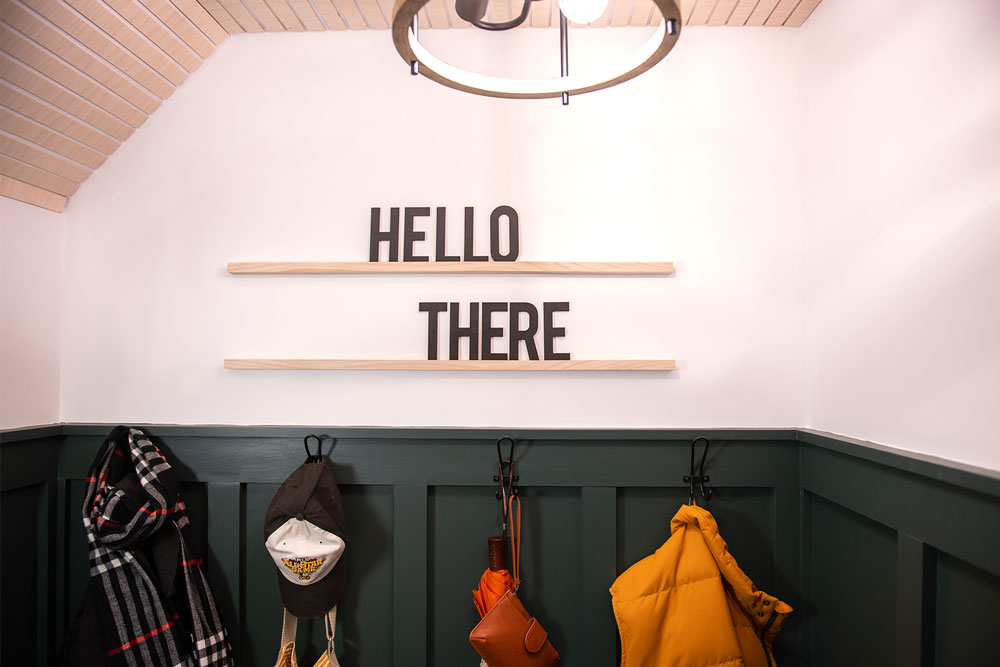
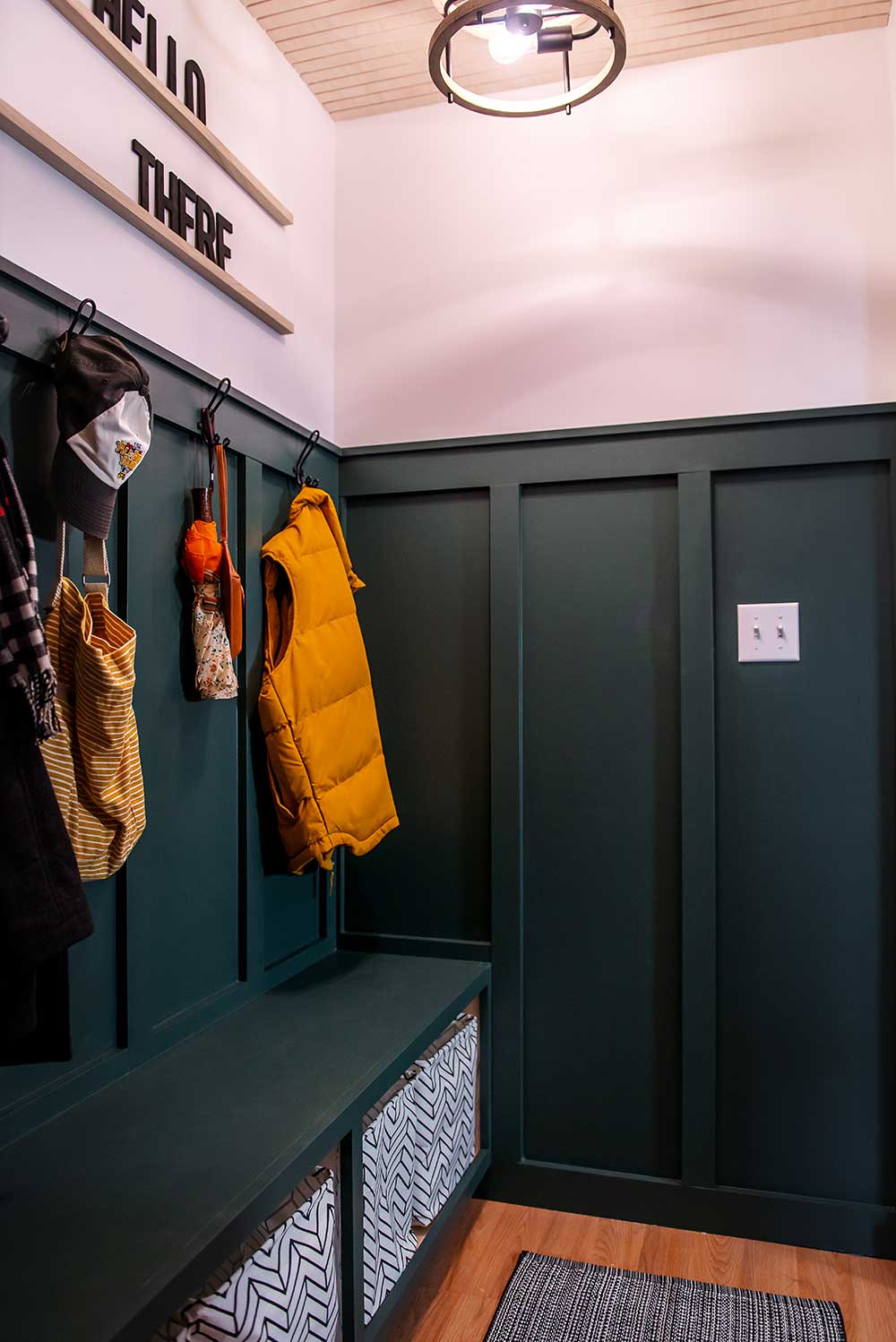
Quick Tips from Christy:
Q: I thought primer was just to cover up dark paint colors before painting with a new, lighter color. Do I really have to prime?
A: Yes. You do. Primers lay a foundation that is multi-purpose. Primer is not just to make the aesthetics of your paint more pleasing. Although this is true, you should primarily view primer as a sealant.
Q: A sealant?
A: Yep, something that seals another material like drywall or wood. KILZ brand primers come in a variety of types to serve specific substrates. For me, I needed a primer specific to coating new drywall. Drywall has zero protection against moisture and, in fact, is engineered in such a way that can actually make it pretty susceptible to attracting water. Priming with KILZ Drywall primer is going to protect your drywall from moisture. If we’re talking about wood, using KILZ 3 Premium can seal in tannins and resins that are naturally found in wood to lock them in so that they don’t bleed through your topcoat.
Q: Why is the moisture such a big deal?
A: Materials like drywall & wood are porous in nature. This literally means that if not sealed properly, they can take on water. What’s the big deal, you ask? Sometimes this is a really sneaky amount of water that you have no idea is accumulating in a space. Over time, water can grow mold… and I’m a nurse too so I’ll try not to bore you with the health implications here but mold can be extremely dangerous for people with breathing conditions like asthma.
Q: Does roller type/nap matter?
A: Yes, it does, and I’m not the type of person to buy the insurance plan for my cell phone if that gives you any indication on whether or not you can trust me when I say this: roller quality is real and you need to spend the couple extra bucks for the higher quality roller. A ½” nap will work in most interior painting applications.
Q: What’s one benefit of priming with KILZ that most people don’t think of?
A: A layer of primer beneath paint actually makes your topcoat more durable! With a young family, my walls see a lot of action. Sports bags get chucked at them, shoes get kicked off, and lots and lots of hands touch the walls. Durability is something that my paint needs to have!
Alright, there ya have it. Hope this was empowering, entertaining, or educational for you! Please reach out to me on Instagram at @oakhillmillworks with any other questions you might have. I’ll always do my best to help.
Christy
Always remember to refer to our website kilz.com or product back labels for additional information on which primer is right for your project and detailed instructions on how to apply our products.
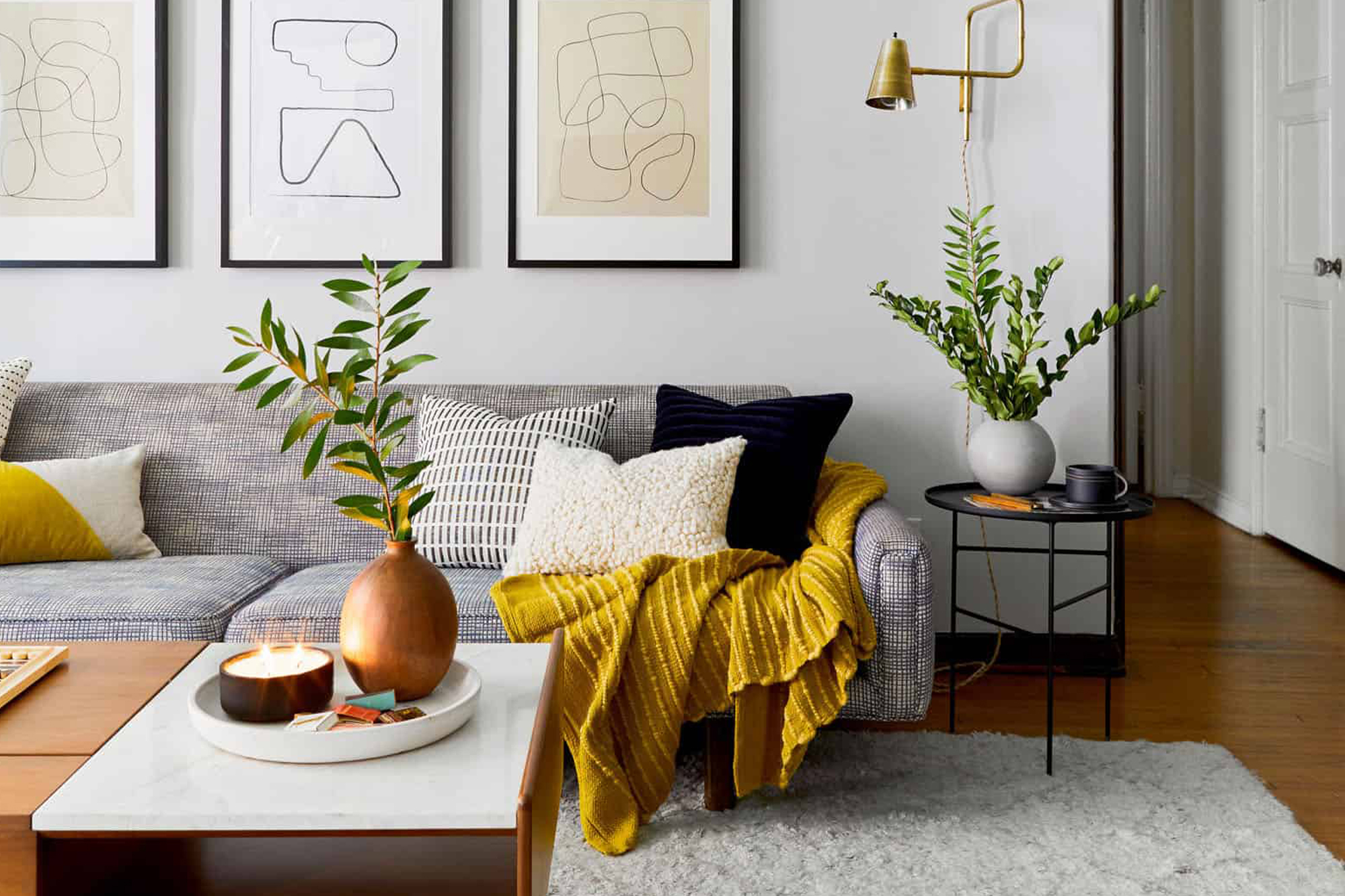
Smart Spaces with Emily Henderson
February 19, 2021One of the biggest design “trends” we’re seeing as we move into this new year is multi-functional spaces. We put “” around the word trends, simply because while we are seeing plenty of beautiful multi-purpose spaces pop-up, the trigger for these transformations is often an essential need. The need for a place to log on to your zoom calls that isn’t your couch or kitchen island, the need for kiddos to have a place to do their schoolwork that doesn’t devour the dining room table, and even the need to have a place for some peace and quiet (meditation corner anyone?) since the local yoga studio is still closed.
Functional spaces are key to thriving in 2021, so why not make them beautiful too! One of our favorite interior designers and great friend of the KILZ® Brand, Emily Henderson, is a true pro when it comes to designing spaces that not only look amazing but work hard to meet her client’s needs. And like any seasoned designer, Emily knows that proper prep work is essential to professional quality results for every project both large and small. We sat down with Emily to get her tips and tricks for creating multi-functional spaces, learn how she properly preps her projects and get a sneak peek at a home office reveal she’s currently overseeing.
Hi Emily! We’re so excited to have you on the blog today. You’ve been a KILZ fan for some time, can you share what you love most about KILZ and why you trust KILZ products for your own projects and for your clients?
Hiya, thank you! A couple things: first – and I think this is the biggest one – it’s just a huge time saver. And it emboldens us to take more risks. And lastly, I guess it’s just a good, functional product. I can elaborate!
I think it’s a pretty commonly shared opinion that painting is the most affordable, most impactful thing you can do to change the look of the space. I agree with that! But if you want to make sure that your paint job actually looks good, you’re going to want a great blank canvas behind it. KILZ is the brand that all of our painting contractors use to prime our spaces, so there was a default level of trust there already – if you’re ever on a construction site before paint goes up, I’m sure you’ll see tubs of KILZ everywhere – but they use it because it makes their lives easier. Walls are smoother, paint sticks better, some of the primers even have mold- or mildew-fighting properties. (We used one of those primers in our windowless basement bathroom.) Instead of schlopping on coat after coat of paint and hoping for even coverage, it’s nice when you can just prime and then roll out two coats.
But also, it’s fun to have KILZ in your back pocket. My team in particular has been able to go crazy with paint in their apartments – you know, like green trim in the bedroom or purple stripes in the bathroom, but done tastefully! – with the knowledge that they’ll be able to change it back easily when they move out without losing their security deposit. We are genuinely big fans.
What’s one project in particular that you couldn’t have completed without KILZ? And which primer did you use?
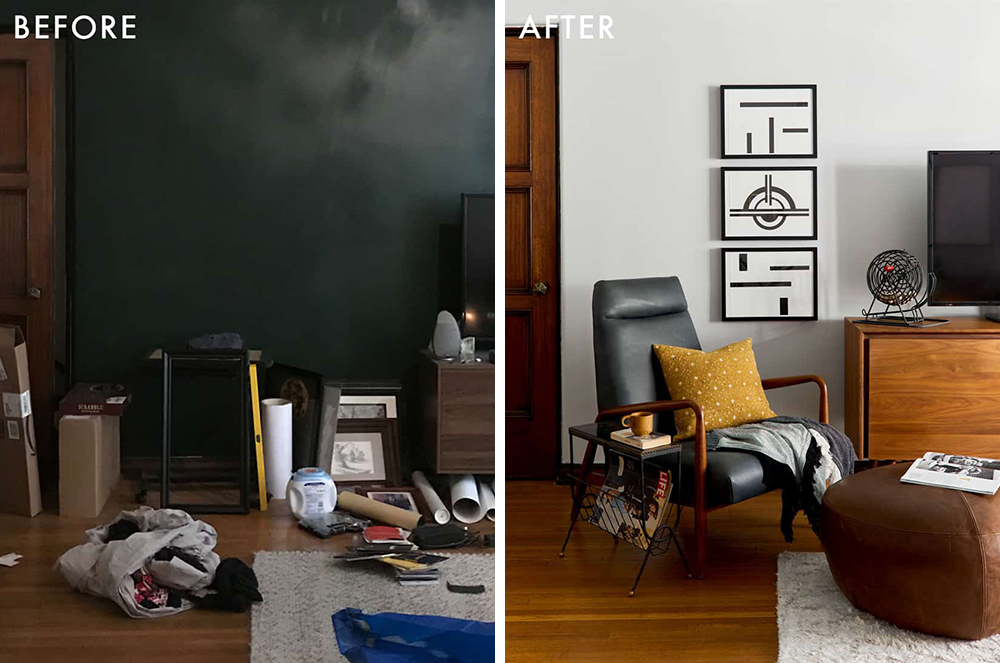
Oh boy, where do I begin? Top of mind would be this living room that my team, lead by Julie Rose, just finished. It was in a historical LA building, right off the first-floor courtyard, and it was dripping with charm…but that black accent wall wasn’t doing any favors. It was just bumming us out. There was only one window in the space, which faced into the heart of the building, and it just made the room feel dark and depressed.
There were a couple problems in the space that we all deal with – not a ton of storage, a pass through layout, you know, the classics – but the main one was really that this wall was overshadowing everything in the space…literally. So we settled on painting the whole space, including the trim, in ‘Chalk Gray,’ brought out our painting contractor and he primed the whole wall in under half an hour – our photographer, Sara Tramp, had popped in to grab progress shots and he had already almost finished by the time she was set up and ready to go.
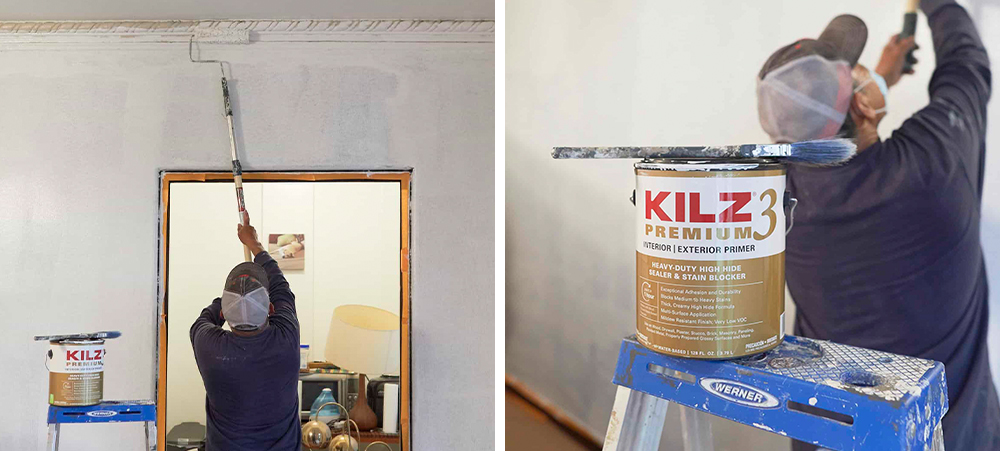
Those photos were taken after one coat. One coat! Do you know how long that would have taken to cover up with just white paint? We ended up priming every wall in the apartment so we’d have a nice, even base and a clean backdrop for our new gray walls and by the time we finished, it was such a beautiful space. The before and afters were staggering. It was like we had breathed new life into the architectural details – once everything had been cleaned up, you could finally see the beautiful moulding and the warm wooden details actually stood out. I’m so proud of how this one turned out.
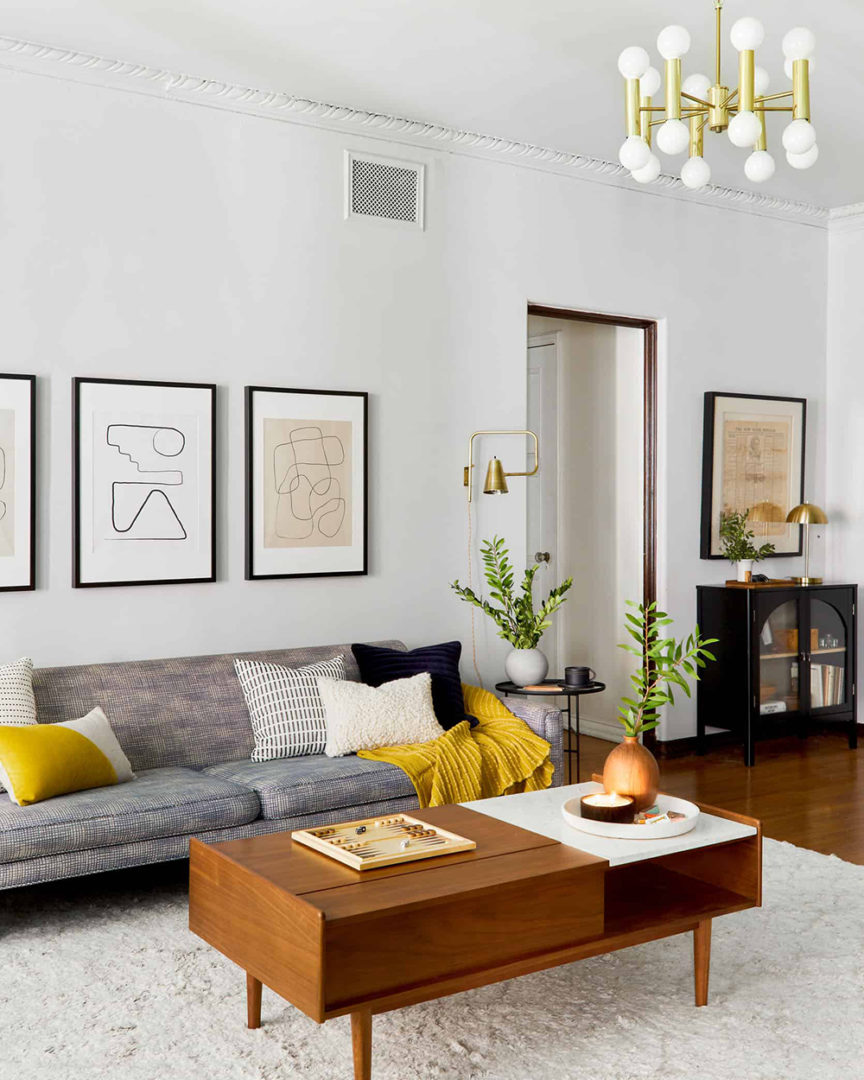
Now let’s talk about prep. What is your advice for a novice DIYer looking to take on a painting project? How much time should they allocate to prep and what steps should they absolutely not skip?
If you’re painting the whole room, take the time to do it right. Sure, you can change paint, but not in the same way that you can swap out a throw pillow or blanket. Before doing anything else, I’d recommend taking 10 minutes to look around and to find and fill all your tiny nail holes or hairline cracks. If you ignore these things and paint straight over them, your eye is going to be drawn straight to them every time you walk in.
My team is split on the value of painter’s tape – actually, my photographer recently painted all of her closet trim freehand after installing a gorgeous wallpaper, out of fear that any tape would pull it off – so I think that if you have a pretty steady hand and a couple of baby wipes, you should feel free to go proceed without taping. You can also throw down drop cloths and make sure to move all your furniture out or to push it to the middle of the room and cover it!
From there, I’d recommend jumping straight into priming. For an average sized room – let’s say 11’ x 12’ – it should take about an hour or two, plus it’ll save you a ton of time on the back end, since you won’t need to paint as many coats to achieve vibrant coverage. The whole process, from filling holes to moving pieces to priming, shouldn’t take more than half a day and it’s definitely worth it.
Like we mentioned in the intro, you’re a true pro when it comes to designing multi-functional spaces. What are the key things you consider when presented with a project to create a room that will meet various needs?
Wow, thank you! There are three big questions to ask: who is using the space? What are the functional requirements? And how do you want it to feel?
For example, a multi-functional space shared exclusively by children, like a playroom or a homework room, and a multi-functional space that needs to work for the whole family, like a rec room, need to be designed differently. A room for kids will have softer pieces to abate the potential for injuries, more open floor space to encourage play, more nooks for alone time, etc. whereas you may float more pieces in a whole family space to encourage smaller zones for each task at hand.
Once you’ve nailed down who is using the space and what it’s for, the most important thing to figure out is how you want it to feel. Try to pick a few words that describe the vibe you’re going for. On my team, some favorites recently have been “warm grandpa library,” “bright art deco discotec,” and “moody old world restaurant.” Picking how you want it to feel when you walk in will really help dictate pieces, layout, and will remove a layer of design analysis paralysis that I think we all struggle with occasionally.
Home offices are by far one of the most popular spaces we’re seeing people DIY. What is your favorite office project you’ve completed recently? (And did you use primer?!)
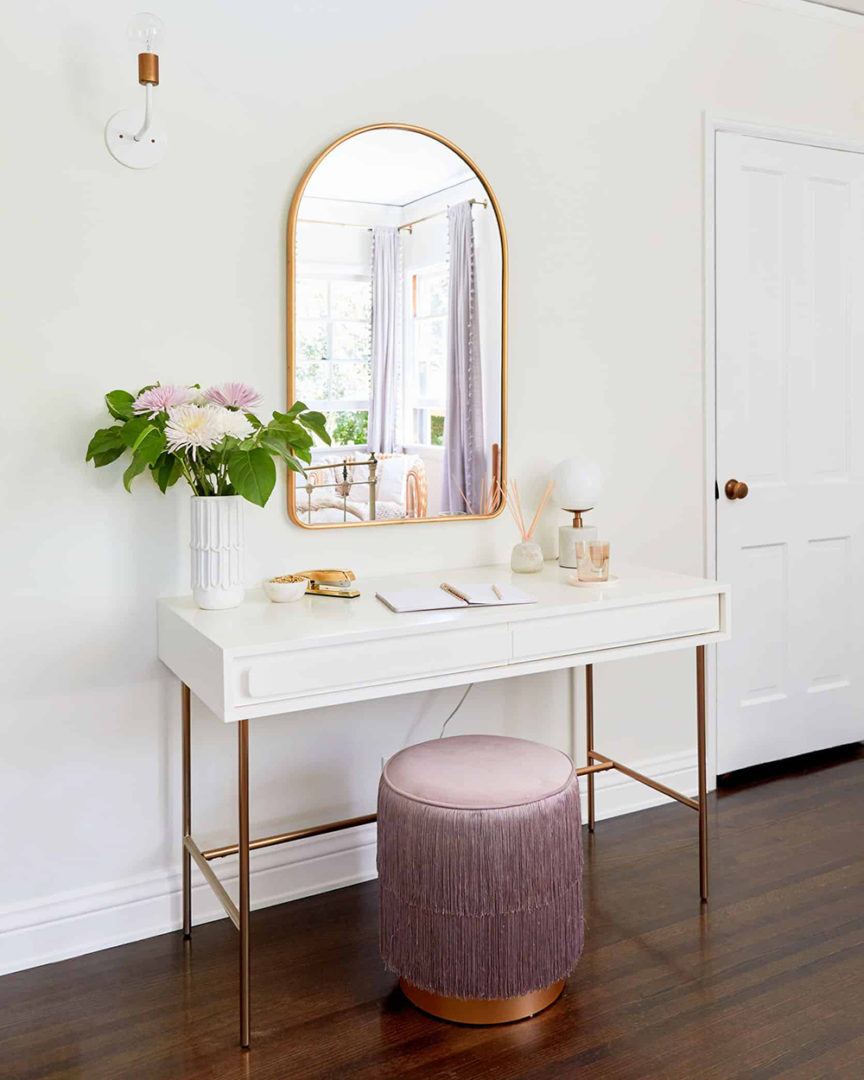
Did we use primer? You jest. Of course we did! My team, again led by Julie Rose, recently finished this teenager’s bedroom makeover, which obviously had to include a multifunctional office space for some homeschooling. I actually designed this space about a decade ago, so it was thrilling to be able to work on its update.
We ended up choosing this vanity in particular because of its size and storage – it wasn’t too heavy for the space and it can pull double duty as the perfect sized desk for a high school student who’s currently just learning from her laptop.
I guess that rolls into my main tips for folks looking to build an office or WFH space. Look for pieces that can serve a few purposes that you’ll still want to look at after you’ve returned to work or school. If you’re able to, try to grab a desk that’s the appropriate scale for your room. This one is a great size for a teen, though I know that some adults will need more space and closed storage. Finally – and the tip I love the most, as a stylist – see how you can accessorize your WFH or homeschooling space to make it feel a little less sterile. The mirror above this desk in question is across from the windows, so in addition to being a great place to get ready in the morning – there’s a cabinet with closed storage in the room, too, in case you’re wondering where the non-school products are kept – it also does a great job of bouncing light around the room.
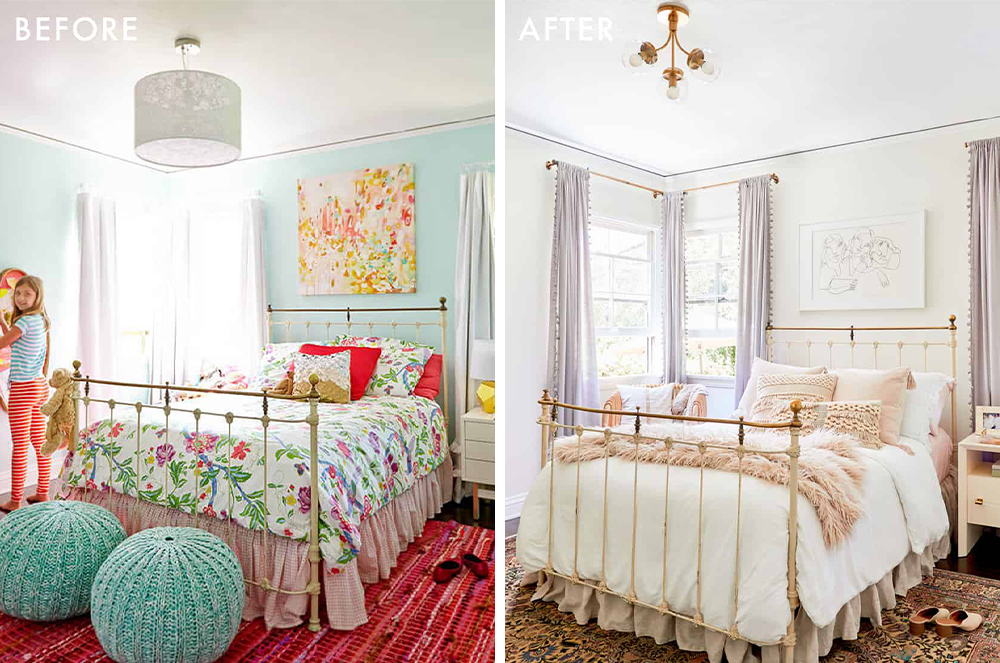
You know I couldn’t leave without a paint transformation photo. Just such a bright, happy, serene bedroom and homeschool space!
One of the biggest woes of a home-office-lacking DIYer is that they just don’t have space for an office. What creative hacks or solutions have you seen to create an office in a small or unique space?
OH BOY. Let me tell you about the project we’re working on right now with one of my favorite new designers, Keyanna Bowen! She’s figured out an incredible way to separate her space and I can’t wait to see it all finished.
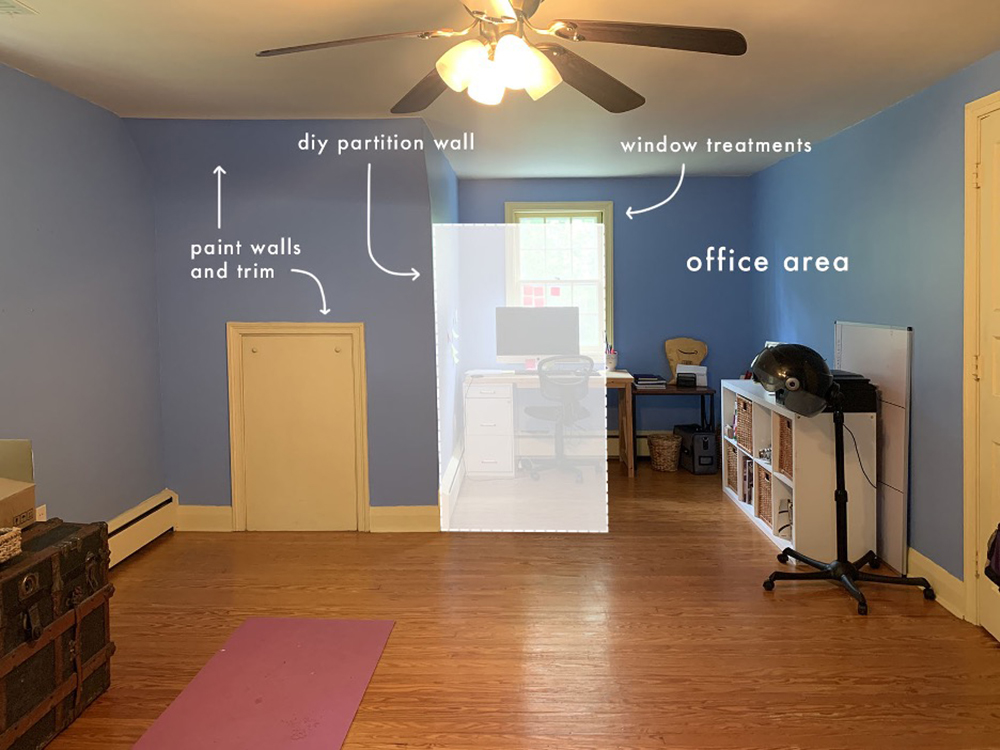
Here’s where we’re starting from. Beautiful! Just kidding – there’s obviously a ton of charm in this room, but it just needs a little bit of a boost. Keyanna wants this space to still serve as a guest room and as a yoga space, so we can’t go all-in on just decking it out as an office. I’m sure that’s a problem most folks at home are familiar with, too! Key’s plan, though, is awesome: she’s planning on building a rope wall partition. A rope wall partition! It’ll hang from the ceiling and it will still let in light while defining the office as its own separate space.
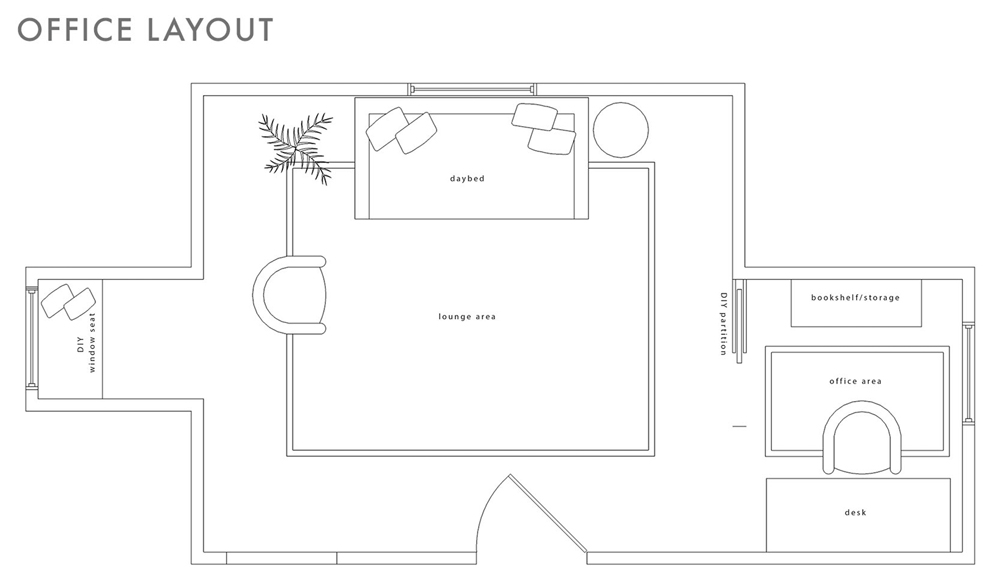
Over the past year, I think my favorite WFH spaces or DIY offices have been the ones where folks have turned their closet into a whole desk setup (long live the cloffice!) or folks who, like Key, have figured out a functional way to use a previously-awkward nook. I’m so inspired! If you aren’t blessed by architecture, though, the idea still stands: is there a way to carve out a corner of your home with privacy screens? Can you hang a similar partition in your living room to give the illusion of a separate workspace? The possibilities are endless.
A word we hear a lot when talking about multi-functional room design is zoning. Can you share what exactly that is and some tips to do it right?
I love a zone! I talked about it a little earlier, but it’s really about figuring out how to clearly define the different functions that take place in each part of a room. The best part: it’s very easy to do! You can set up separate zones in minutes by anchoring areas with different rugs. Key does it beautifully above, with the office and lounge areas both being really clearly defined by their rugs. It makes total sense, because when our brains see different flooring, they think, “oh, different room.”
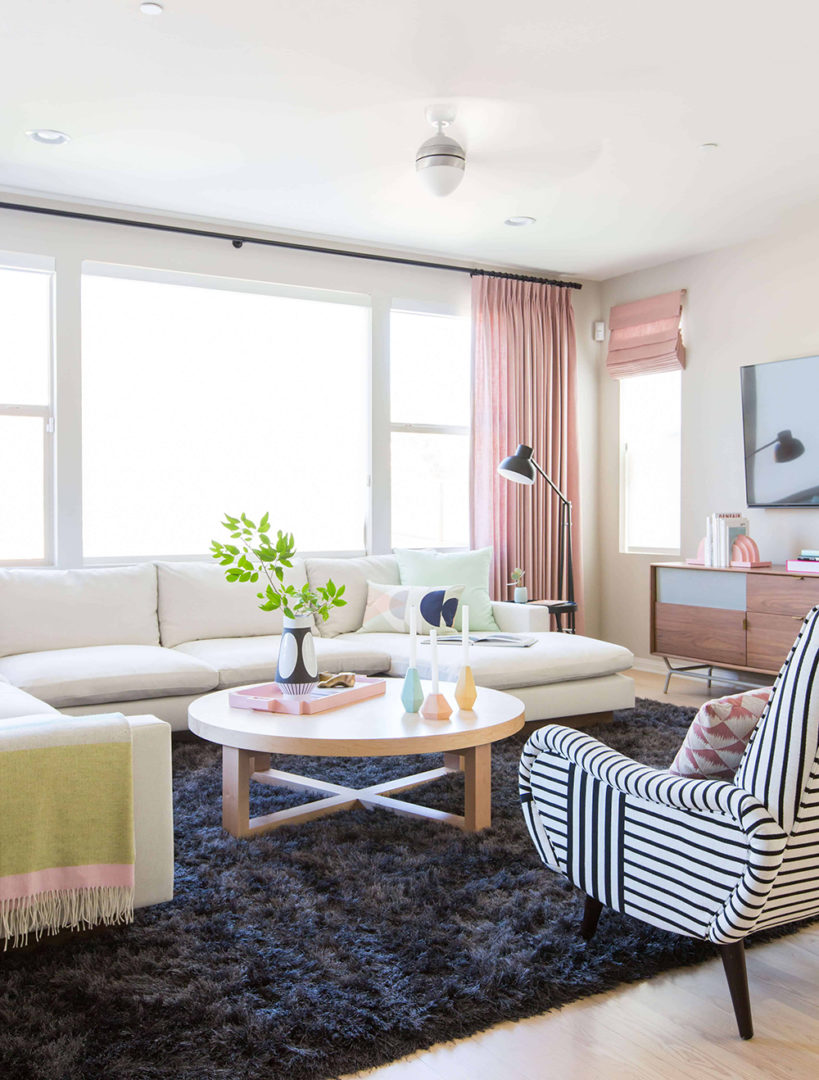
Zoning is really essential for folks with open concept layouts – especially now! So in this project – from 2016, oh my gosh, though it’s still one of my all-time favorites – we created a huge and comfortable family room by flanking this super-soft rug with a huge, u-shaped sectional and two graphic chairs. It’s bright and open, but still definitively its own space.
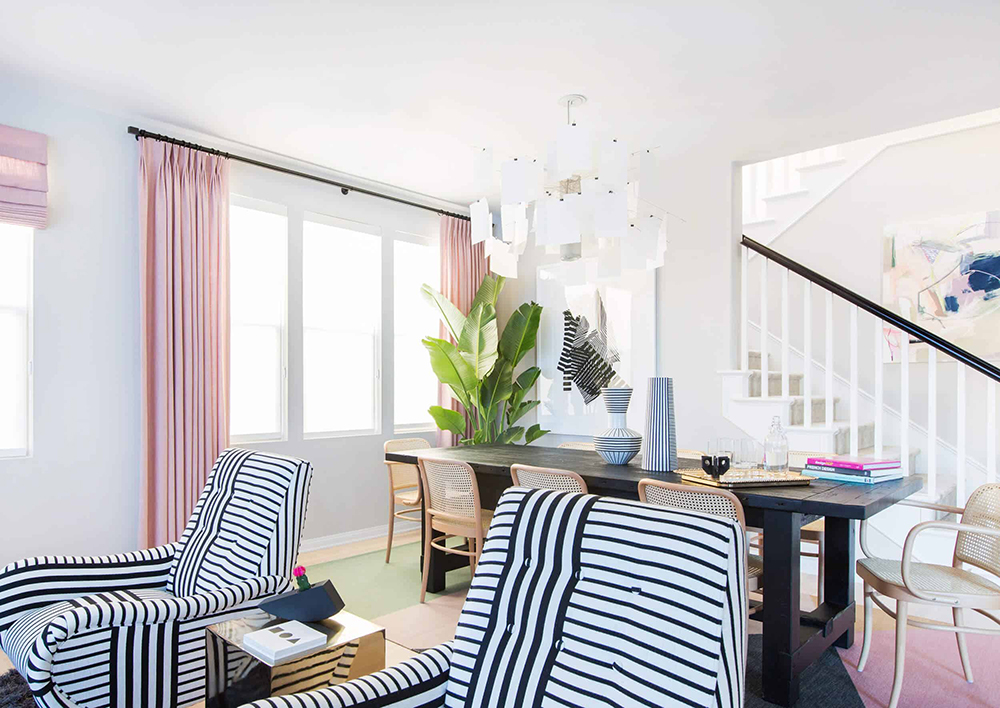
A few feet away, and anchored by a flat, easily-cleanable dhurrie rug, is the dining area. You’ll probably notice a lot of repeating elements: graphic hits of black and white, light woods, and pastels. Keeping a cohesive color palette isn’t always necessary – I am all for exploring, playing, and getting weird – but it does make the design process easier and it’ll make your rooms feel more relaxed and comfortable.
Switching gears to home-school rooms and kid’s study spaces. What was the biggest hurdle in creating a functional space for little ones?
Making spaces so that kids will actually use them! I think that a lot of the time, design-minded people like myself can get really hung-up on the vision. We want to make something beautiful and impressive and worth sharing, but kids don’t necessarily share those same motivations. They just want a fun place to play, learn, and explore.
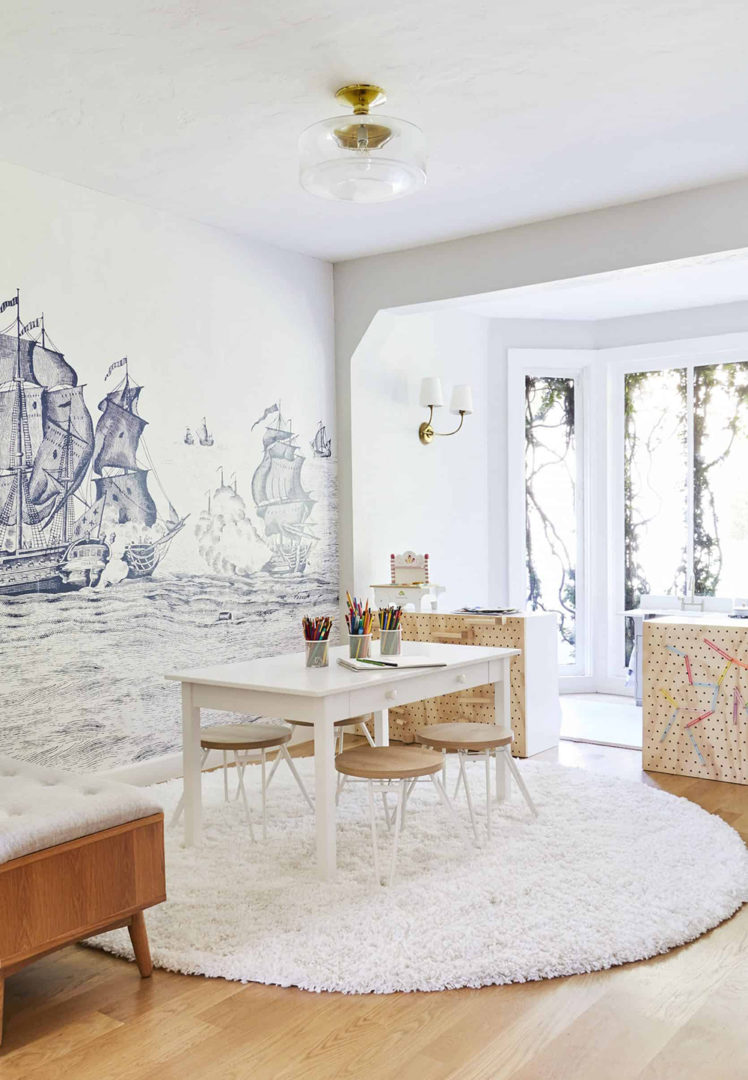
The playroom is actually the space I struggle with most. My kids are still very young – 5 and 7 – so we’re early in the homeschool process, but they love art and playing with legos, so once I chose to design for those two hobbies in particular, it immediately became more functional and the kids used the space way more.
To that end, I’d ask: what do your kids like doing? How does your child actually study or do homework? If they love drawing, give them a space for that and relinquish your dreams of them ever actually wanting to play with the enormous dollhouse you bought in the hopes that you could play with it together. (Speaking to myself, here.) If you build it, with your kids and their specific tastes and interests in mind, they will come.
Can you share a recent personal or client projects you’ve done that included a room for kids? And of course, we want to know how primer came into play!
I’m in love with this room that my team, again led by Julie Rose (are you sensing a theme here?), recently completed for a little girl. We wanted to make a magical bedroom with a specialty art area and I think we really made it sing.
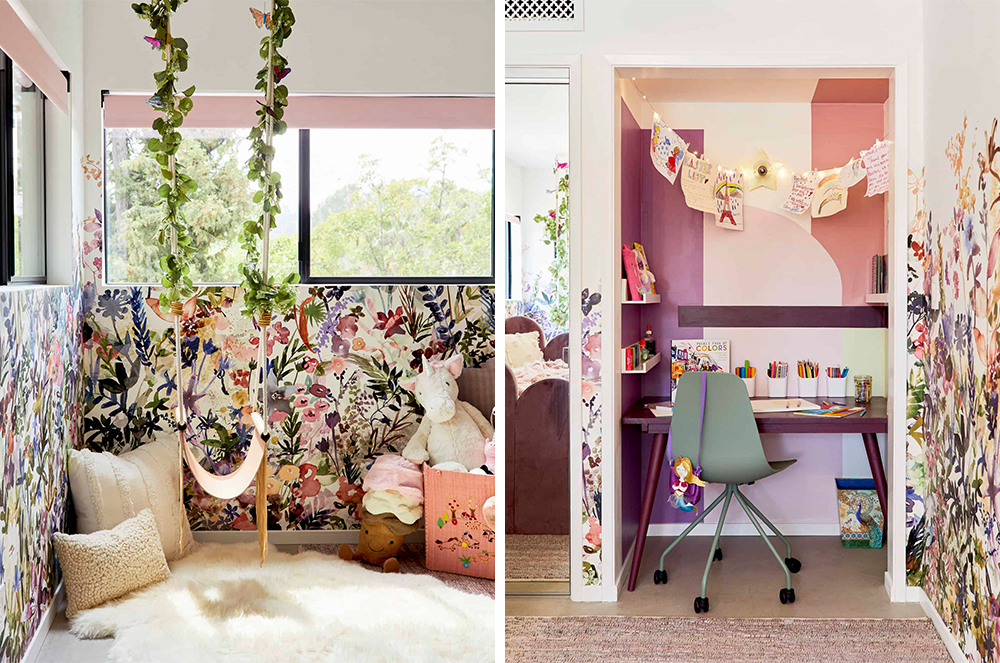
As for how we used primer – it went everywhere! We actually primed underneath the wallpaper, per our installer’s recommendation. It covered up the previous paint and served as a plain backdrop so that the white pieces of wallpaper would appear clean and fresh, but it also worked as a bit of a barrier so that the wallpaper paste didn’t bond with the walls too much. While wallpaper is pretty permanent, priming first can make the removal process a bit less painful in that you won’t need to worry about ripping off chunks of drywall by accident.
We also obviously had to prime that art nook so that all of our magical, fairy-inspired colors would show up. We love the way it turned out and so did the family.
Before we wrap up, let’s talk about the project that we’ve partnered with you on… that also includes your design mentee Key! Can you tell us about her, the project and give us any sneak peeks?
Woops, I guess I already spilled the beans a little bit on this one, but I’d love to talk more about Key! Earlier this year, my team and I decided to take on a mentee – I’ve been so incredibly fortunate to find success in this field and I’m now surrounded by people who are experts in editorial and social and more, so I wanted to share the wealth and hopefully, help more folks find long-term career stability in this weird world of internet design and influencing.
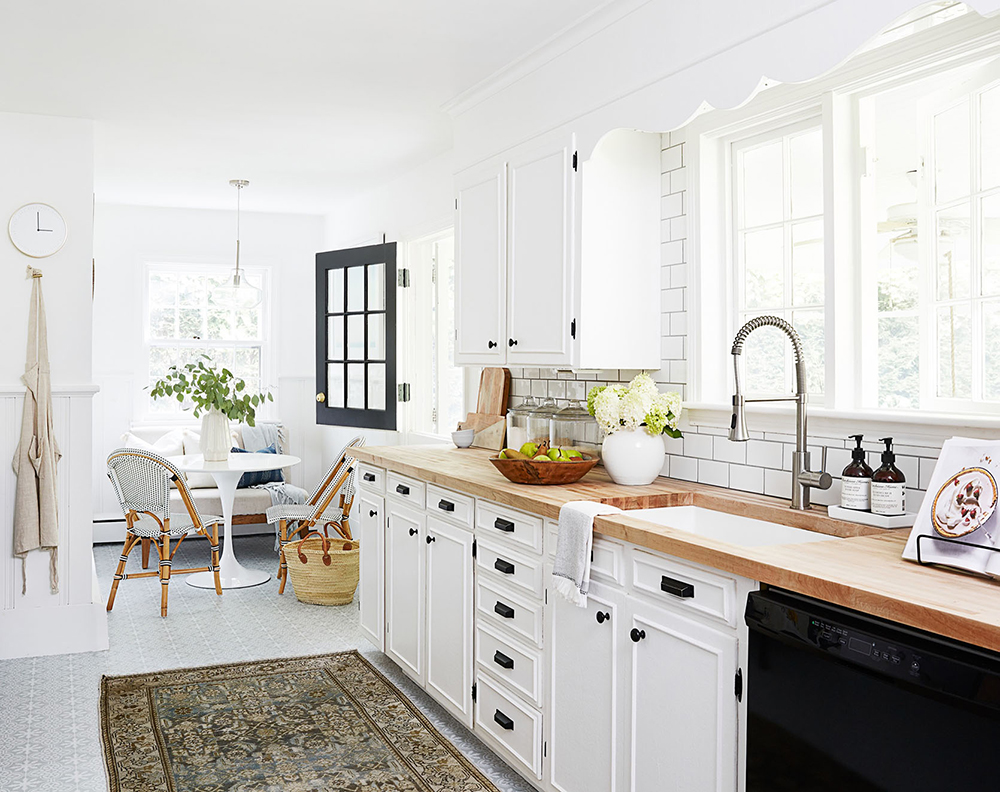
Key was an instant, unanimous pick from the team. She’s an incredible interior photographer in her own right, but we knew once we read her writing and peeked at her own DIY rental renovations – that’s her kitchen above – that she would be the next big thing. She’s warm and creative but she’s also detail-oriented with a perfectionist mindset, which is what it takes to make and shoot and share beautiful spaces for the internet!
We’ll be making her office over – the periwinkle one I shared above – and we’re so excited to work with KILZ because it’s actually covered in oil-based paint, which you can’t cover without using a specialty primer. We’ll have an official update in a few weeks, but I can share the general design direction which is going to knock your socks off…
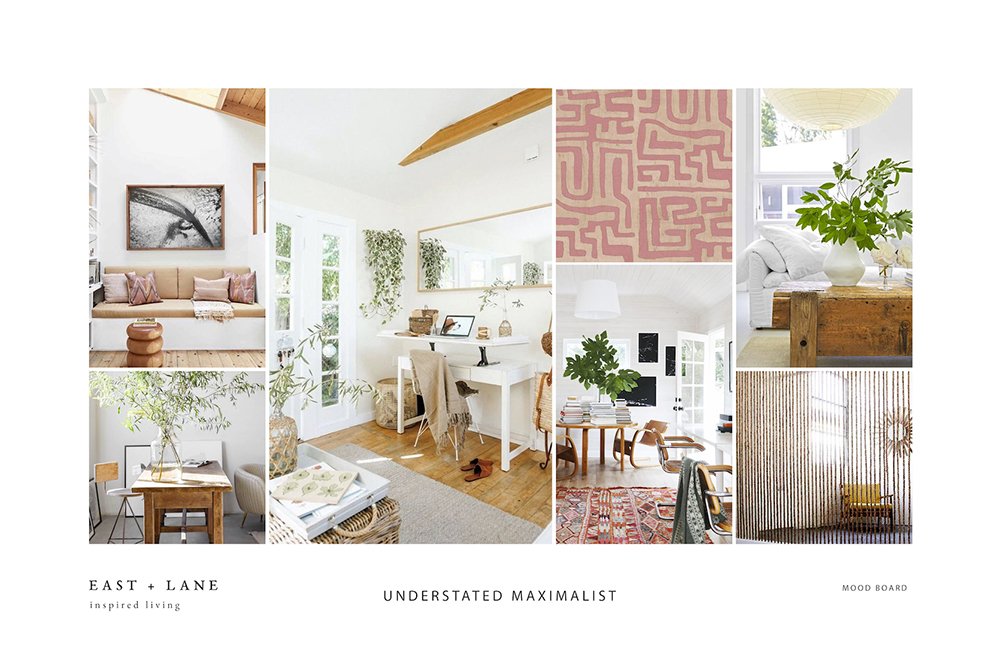
My team and I have been working with Key to secure all the main furniture pieces and BOY, they’re great. (Also, do you see that rope wall partition on the bottom right? It’s so good, isn’t it?) I know it’s only February, but I have a feeling that this is going to be one of our top makeovers of the year. We’re so thrilled to reveal it to you all and so grateful that KILZ has given us the opportunity to work on such a fun project, together. Cheers to beautiful and multifunctional rooms in 2021!
Author is paid sponsor of KILZ Primer. Always remember to refer to our website kilz.com or product back labels for additional information on which primer is right for your project and detailed instructions on how to apply our products.
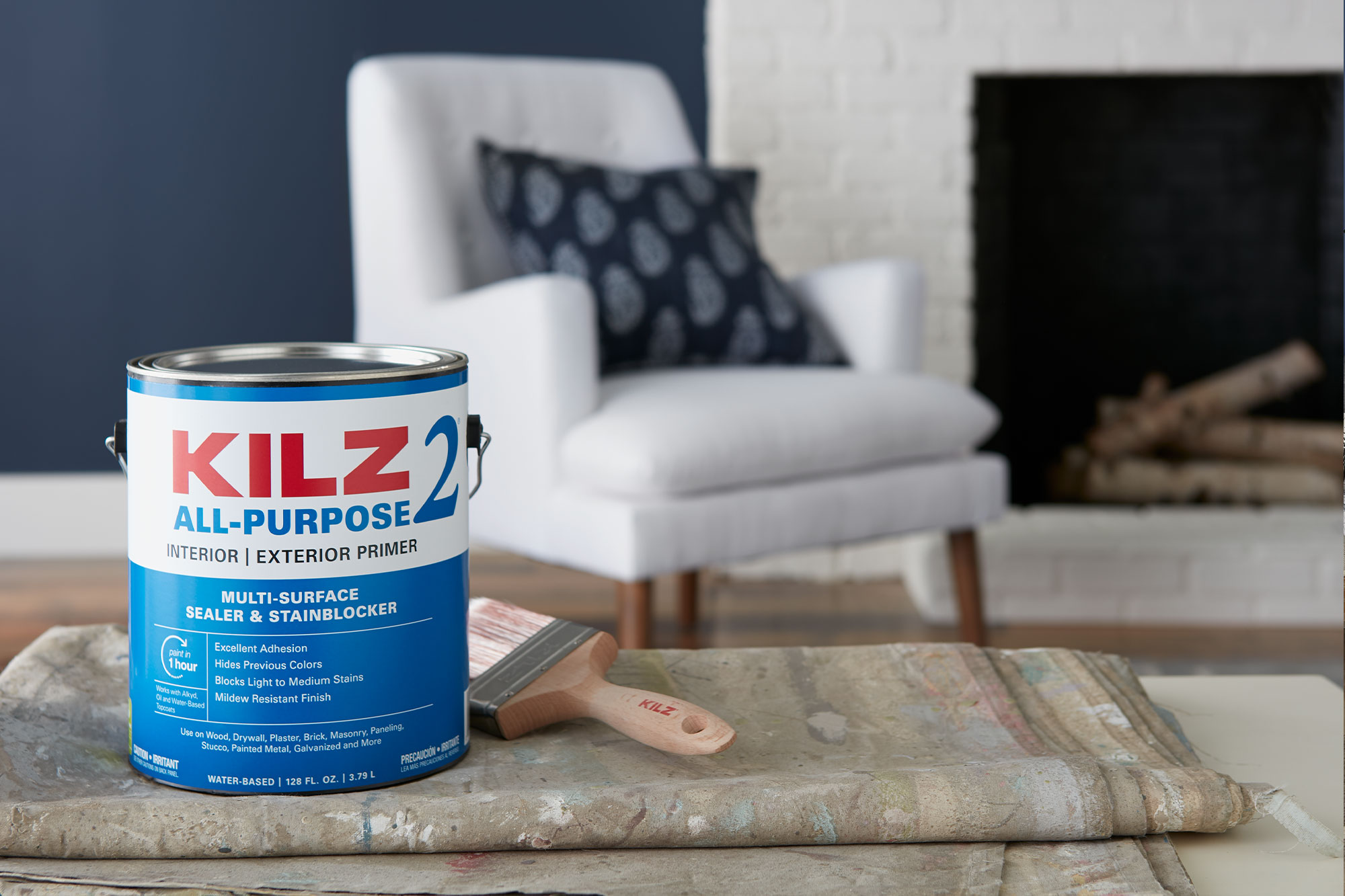
5 Things Primer Does for Your Paint Job
January 19, 2021Primer and paint belong together. A match made in design-heaven, primer helps paint to be the best it can be and is key to getting professional quality results. Read on below to learn five things primer does for your paint job and get inspiration for your next painting project.
Primer Makes Your Paint Job Durable
Over time, fluctuating temperatures and humidity levels can make paint peel. For spaces where this is normal like kitchens, using KILZ 3® Premium Primer (known for its exceptional adhesion and durability) before you paint can help ensure your paint job lasts longer. See the full kitchen transformation with step-by-step instructions here.
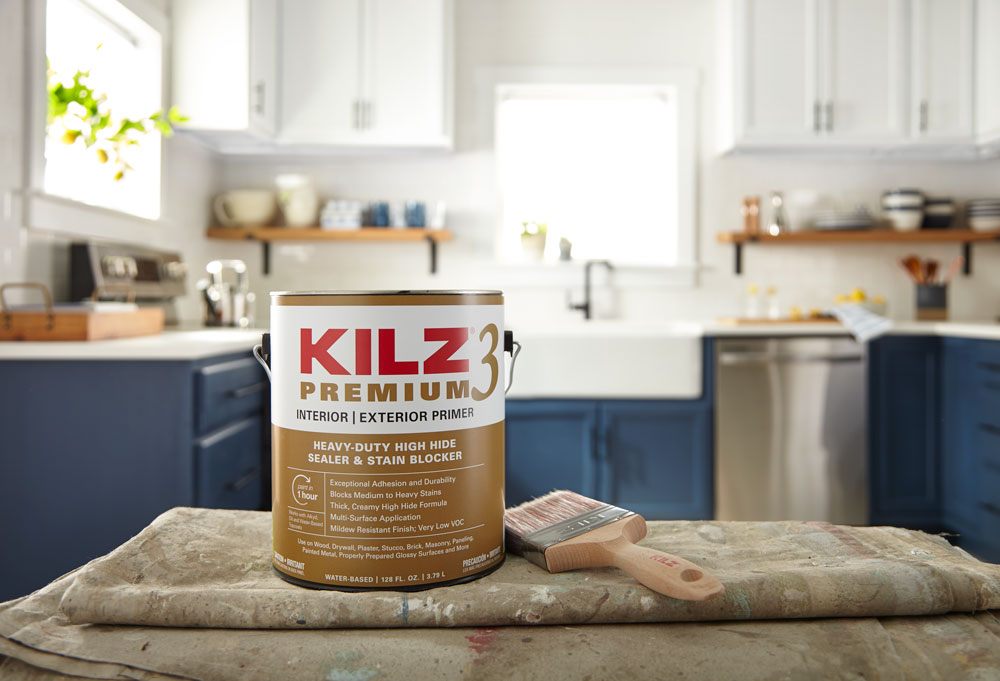
Primer Seals and Blocks Stains
If you have a wall with unpleasant stains, for example smoke stains from a previous homeowner in a bedroom, KILZ® Original Primer with its powerful stain blocking formula is the one for the job. See how we freshened up a mid-century modern bedroom with primer here.
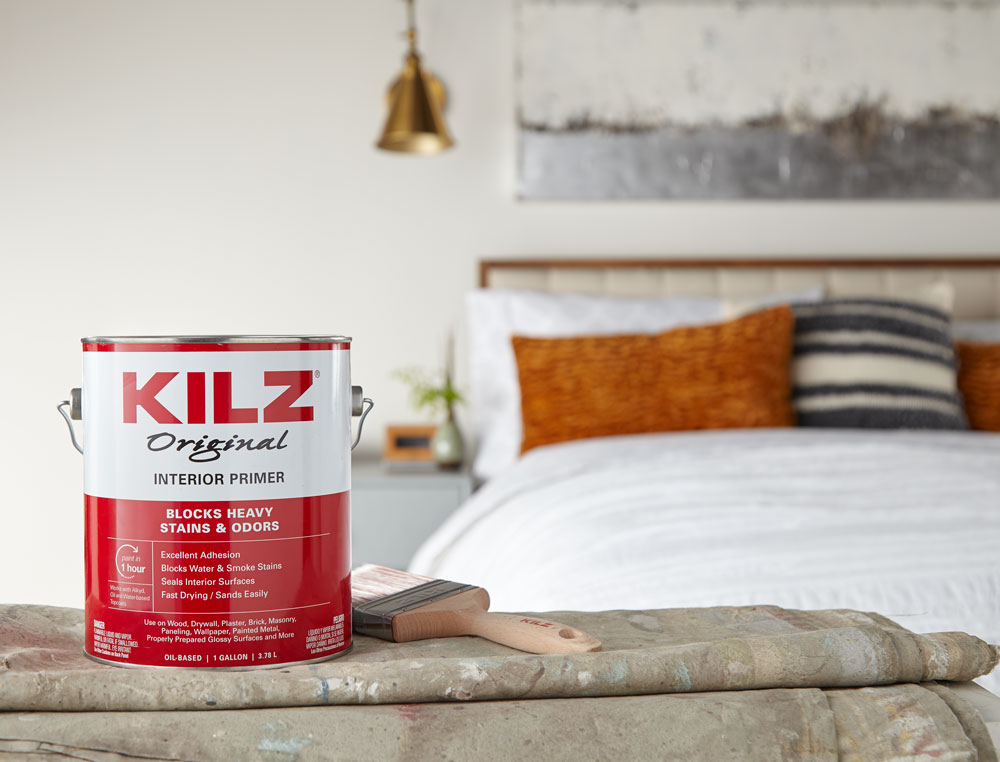
Versatile Multi-Surface Sealer
When you want to paint a porous surface like brick, you want a primer that seals the surface. KILZ 2® All-Purpose Primer is a versatile multi-surface sealer perfect for the task. See how a freshly primed and painted fireplace pops against on-trend navy walls in this post.
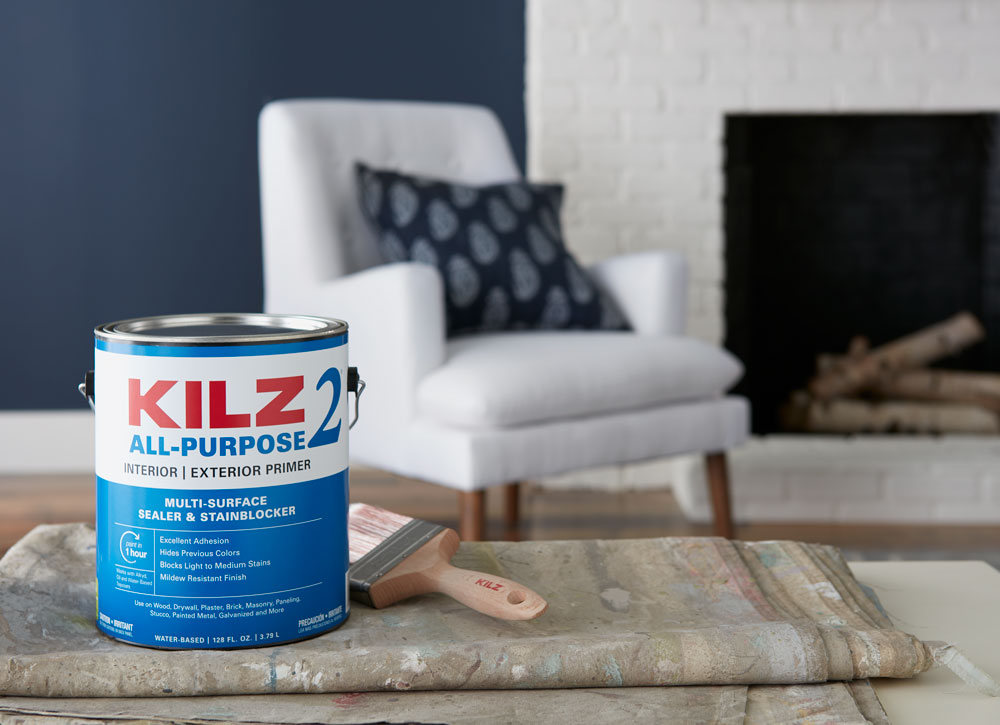
Primer Hides Dark Colors
When you’re applying a new paint color, the last thing you need is your old color seeping through. That’s why KILZ 3® Premium Primer is a great primer choice when going from a darker color to a lighter color. It hides dark colors and creates the perfect base for your new topcoat paint. See how KILZ primer turned a dark spare room into a sunny and sweet nursery here.
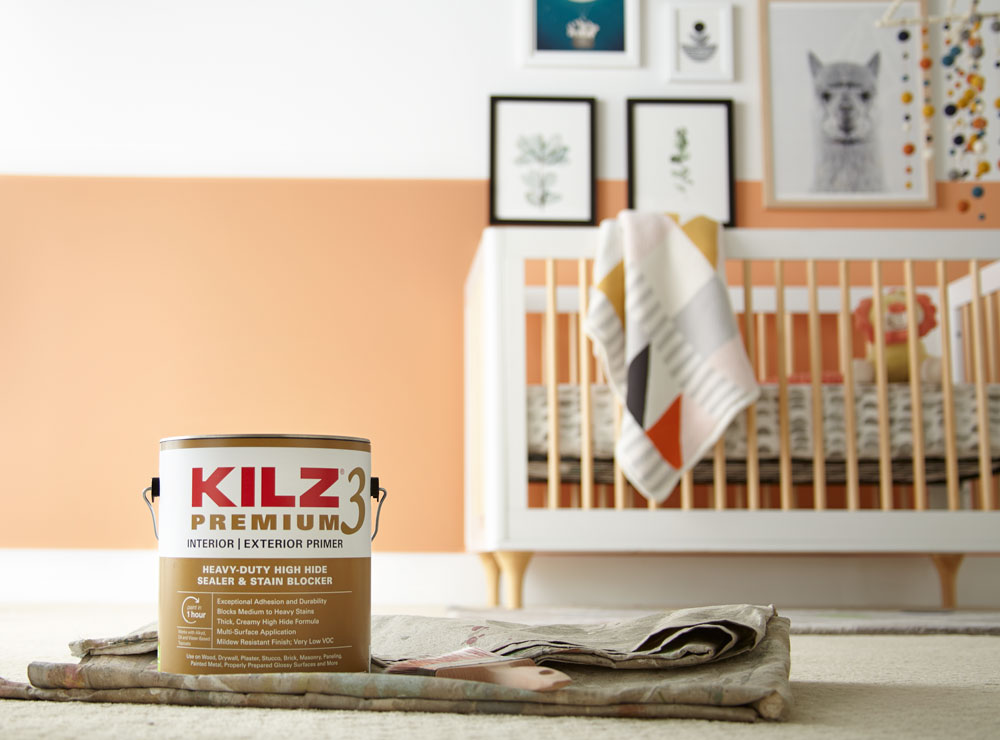
Primer Has a Mildew Resistant Primer Finish
In high humidity areas, like bathrooms, KILZ® Kitchen & Bath Primer is up to the task. It dries with a mildew resistant primer finish that helps protect and support paint. See the full bathroom transformation here.
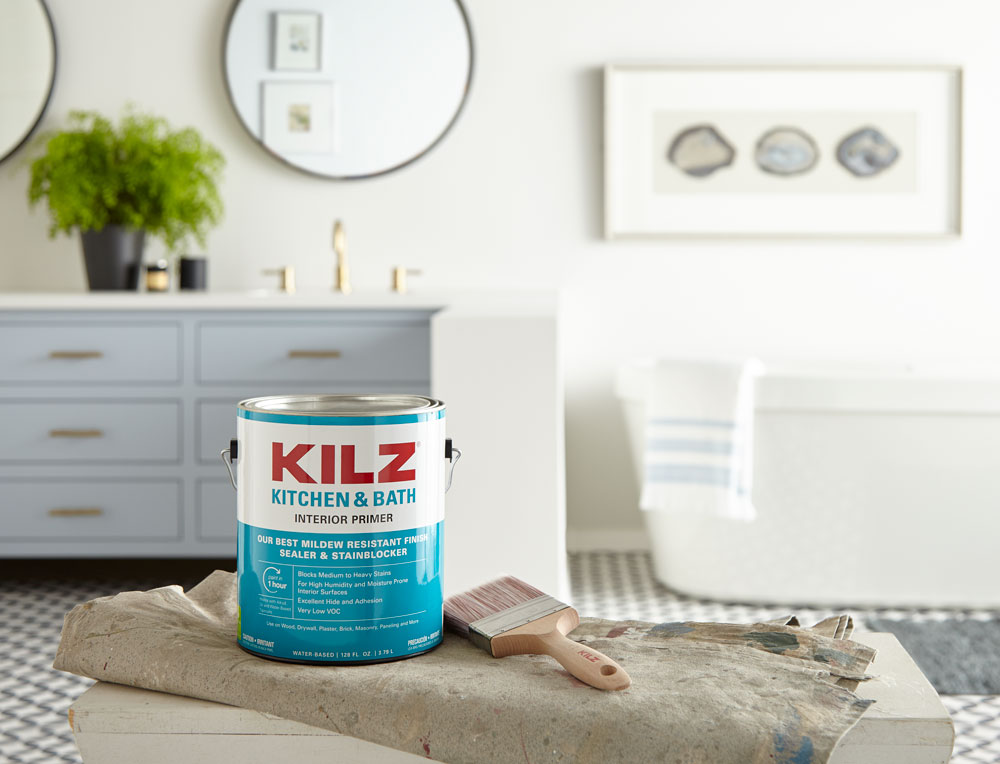
Always remember to refer to our website kilz.com or product back labels for additional information on which primer is right for your project and detailed instructions on how to apply our products.
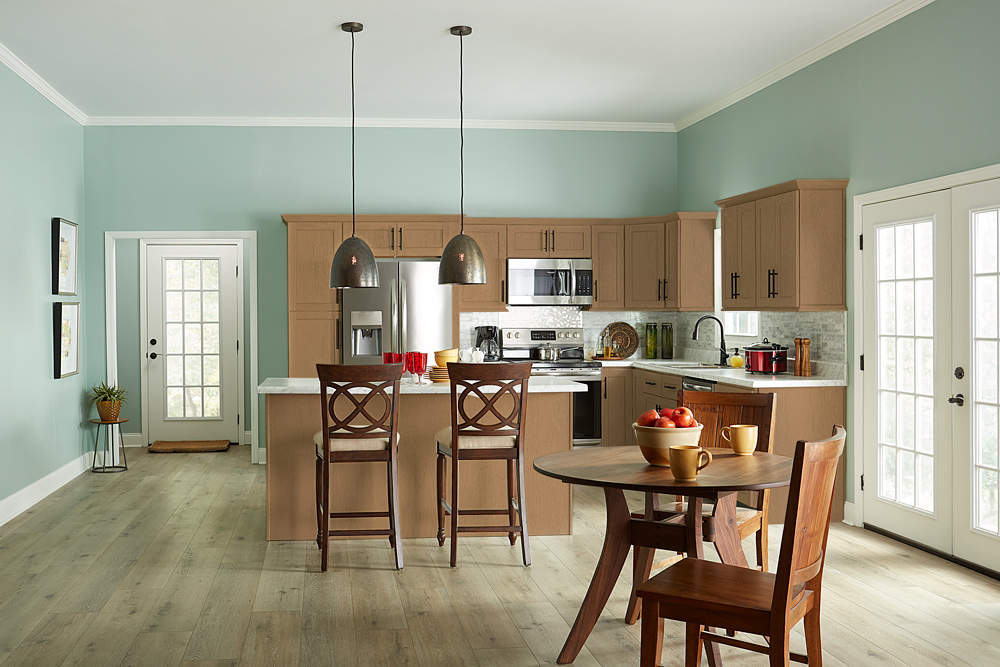
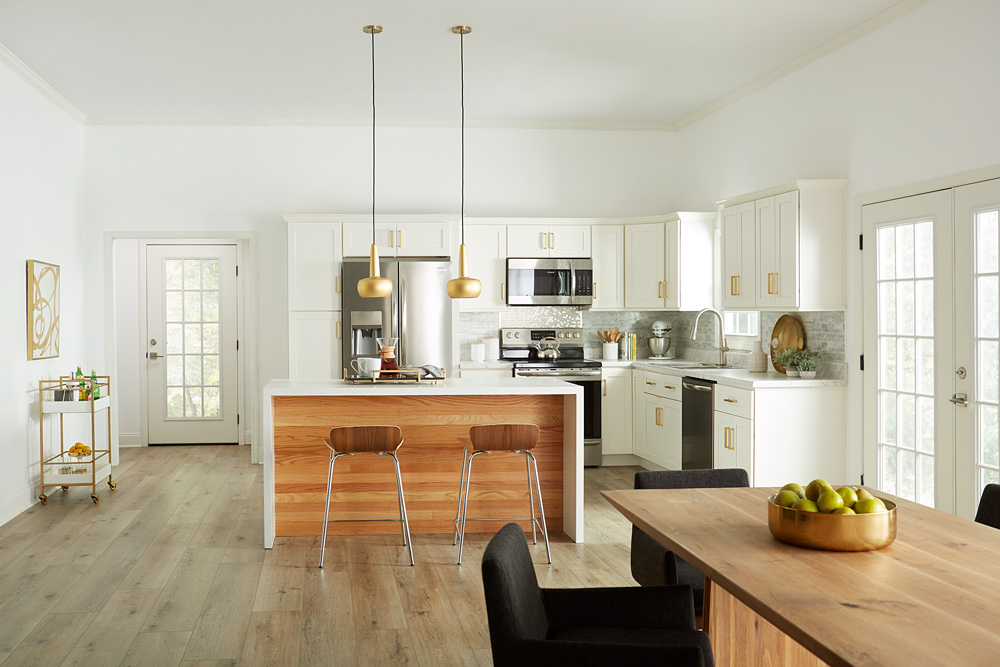
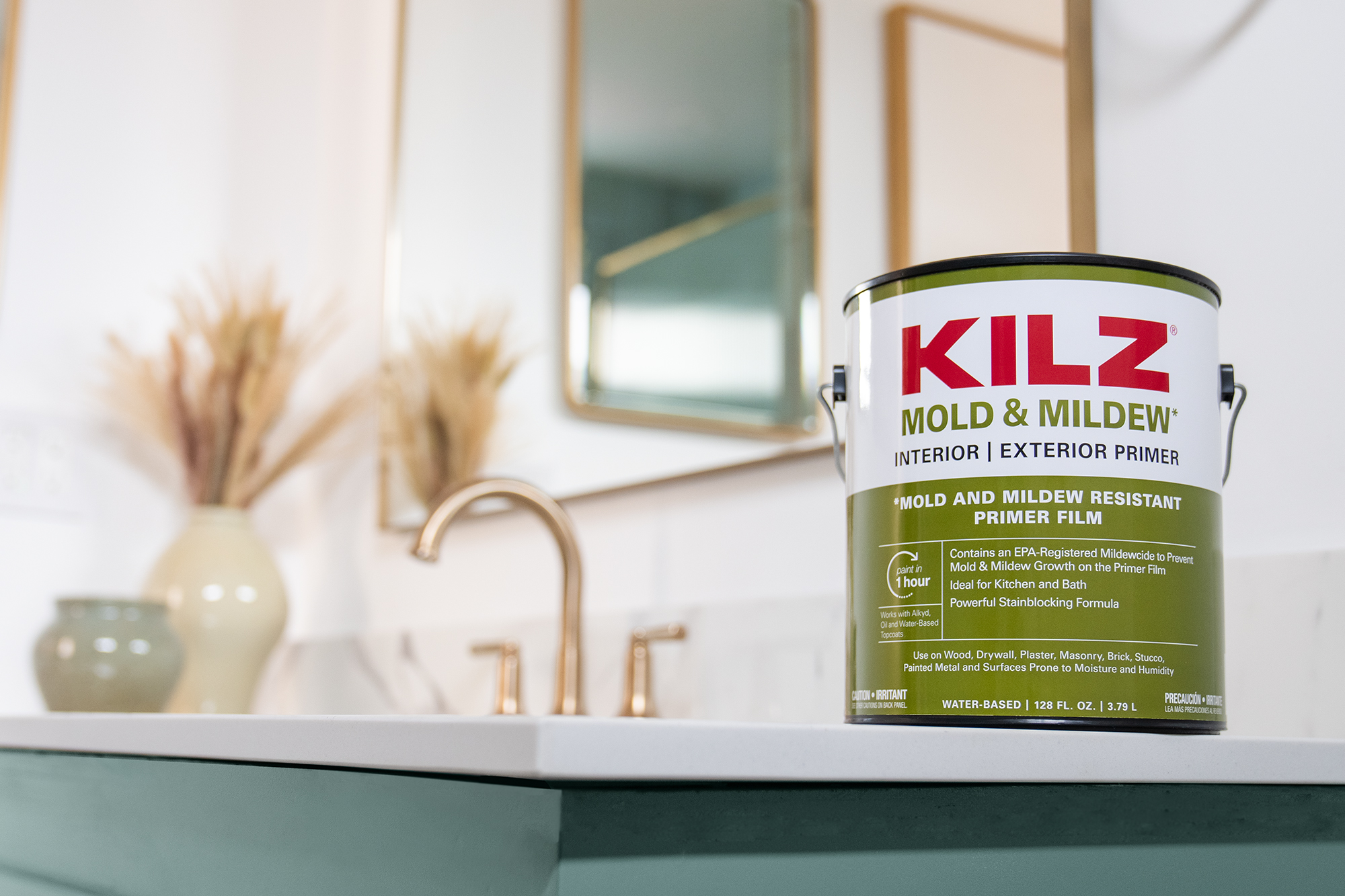
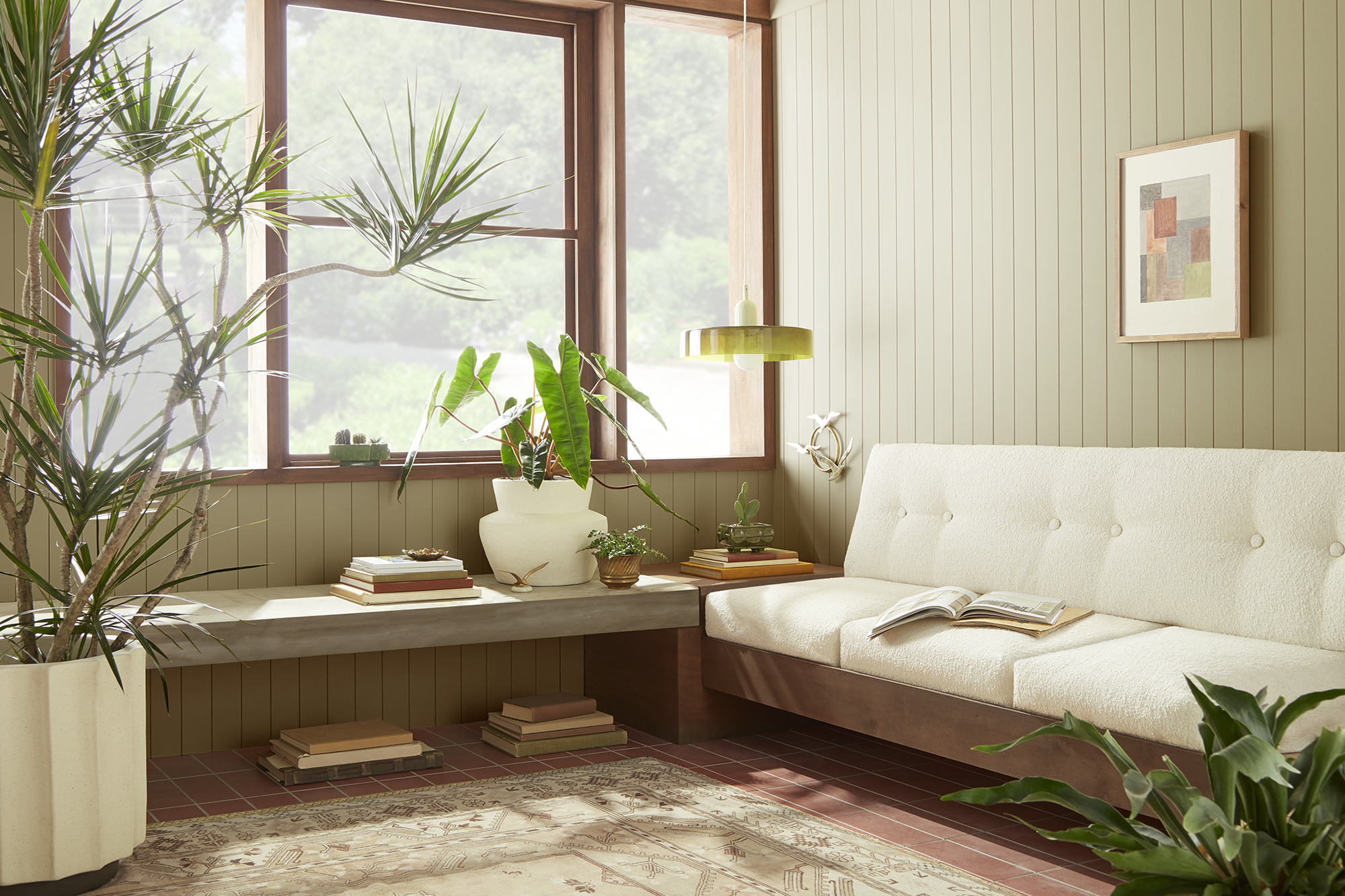

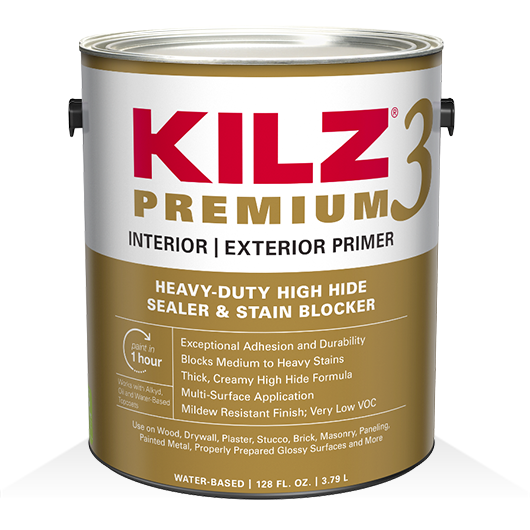

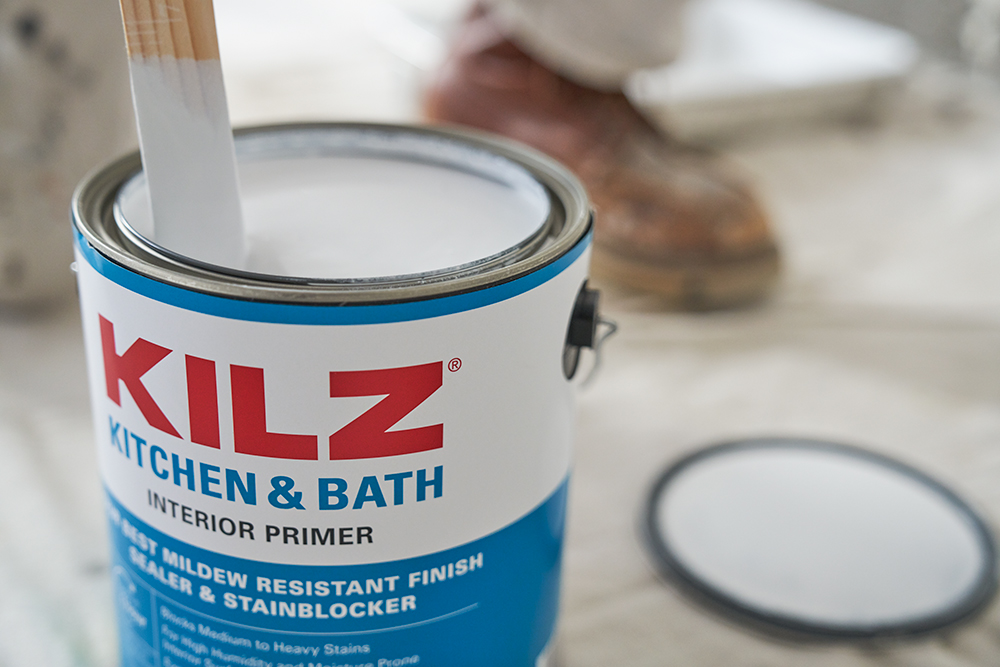
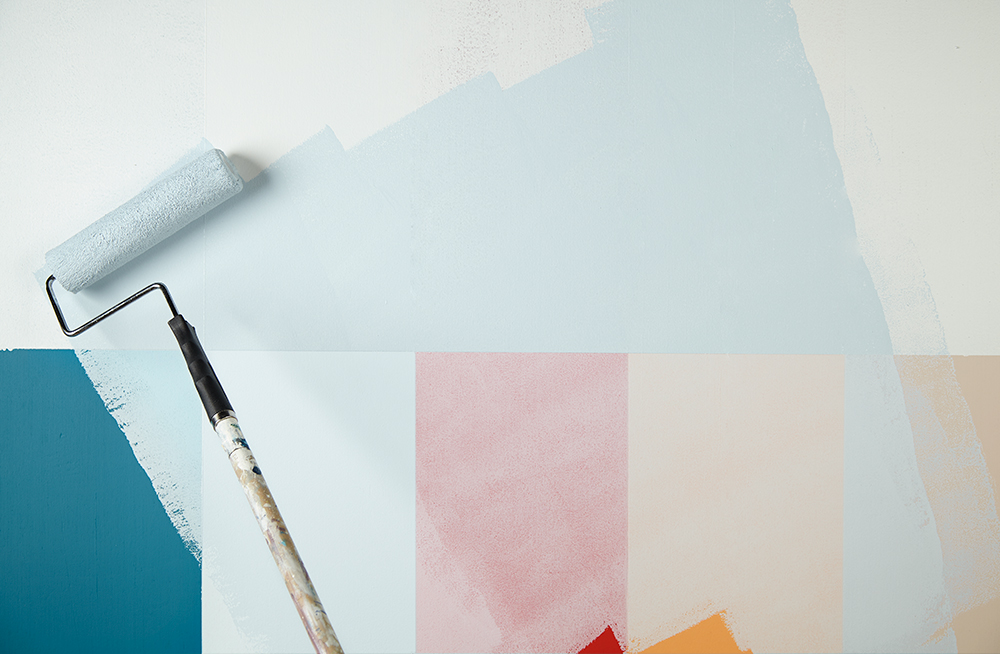
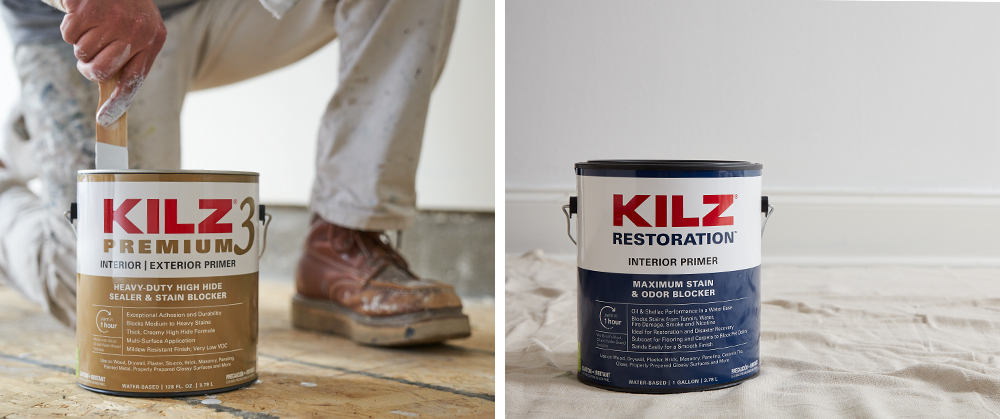
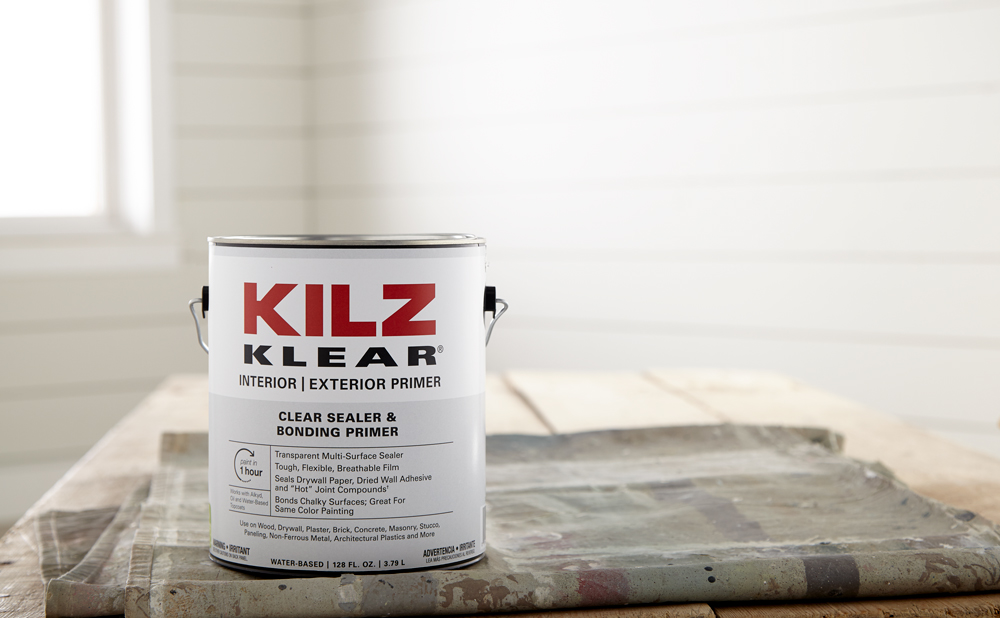
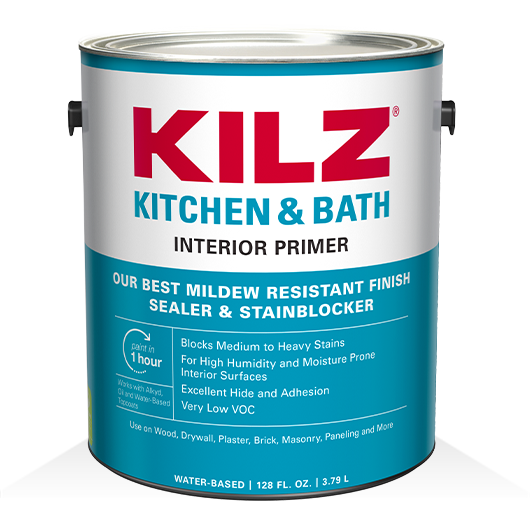
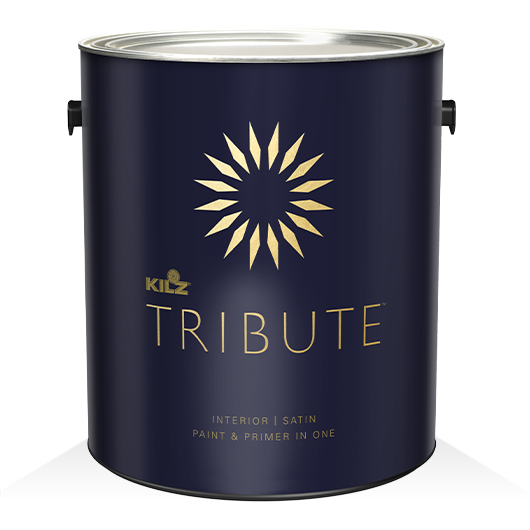
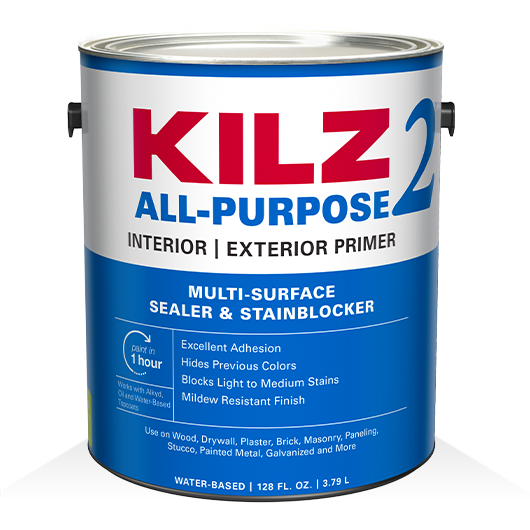
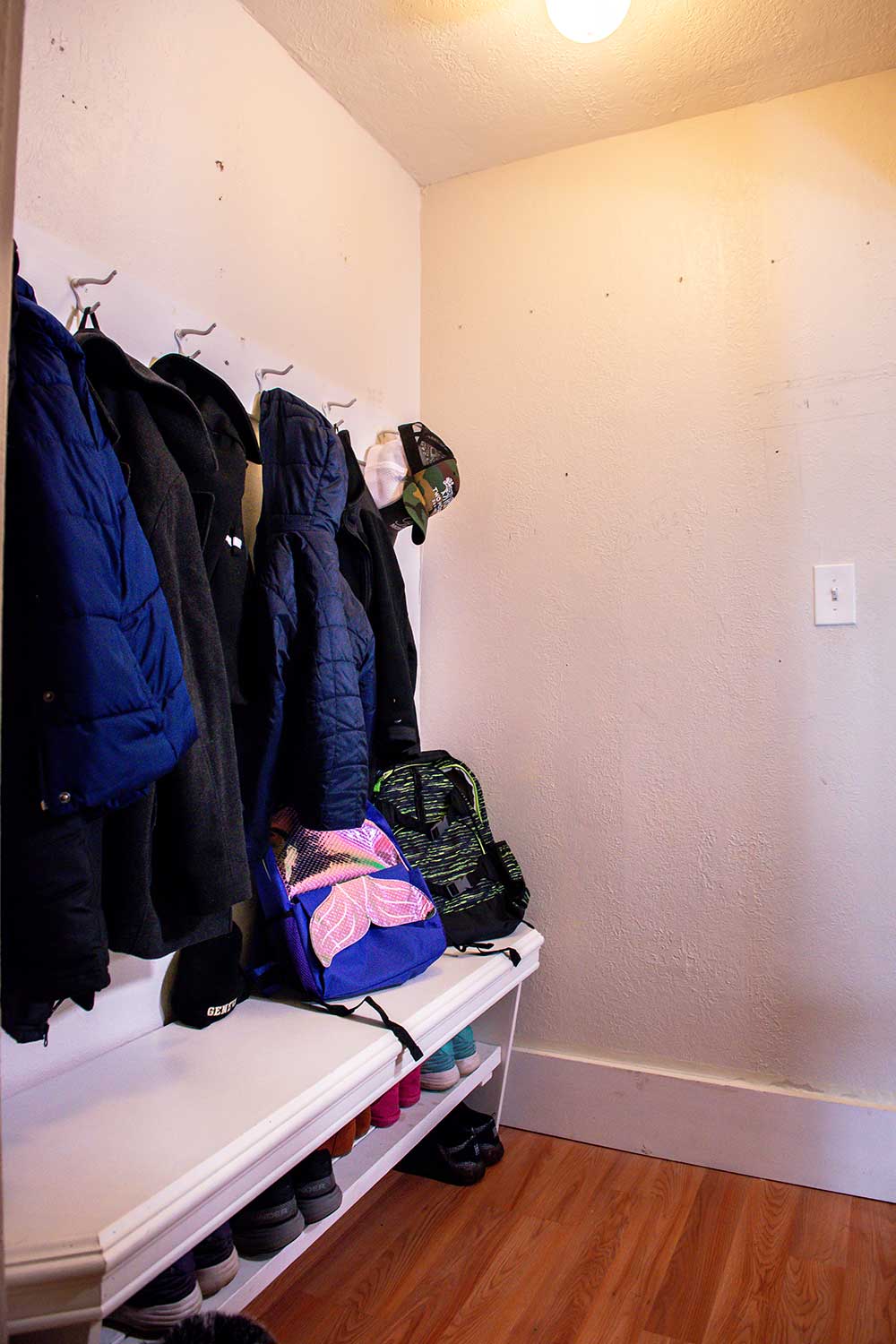
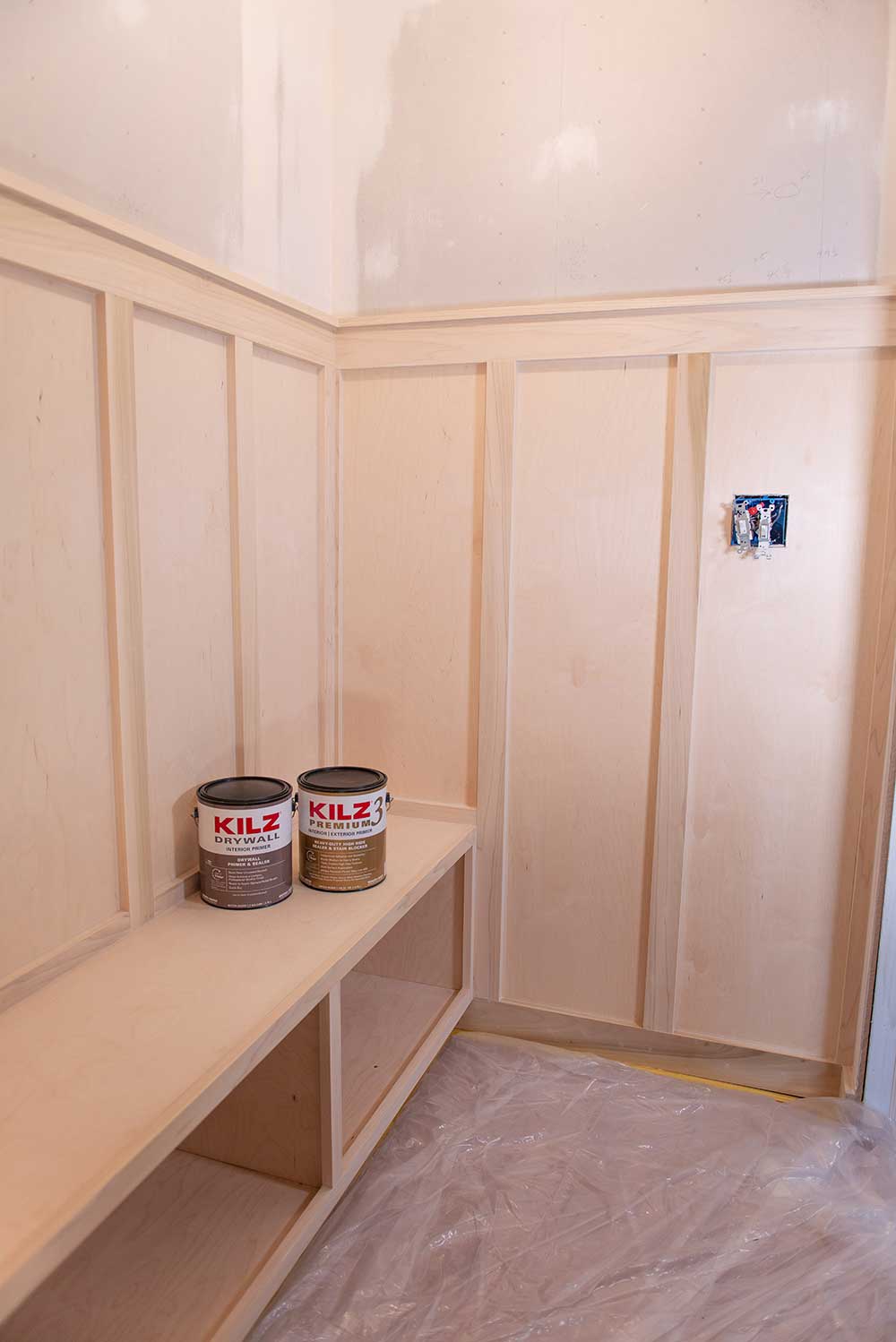
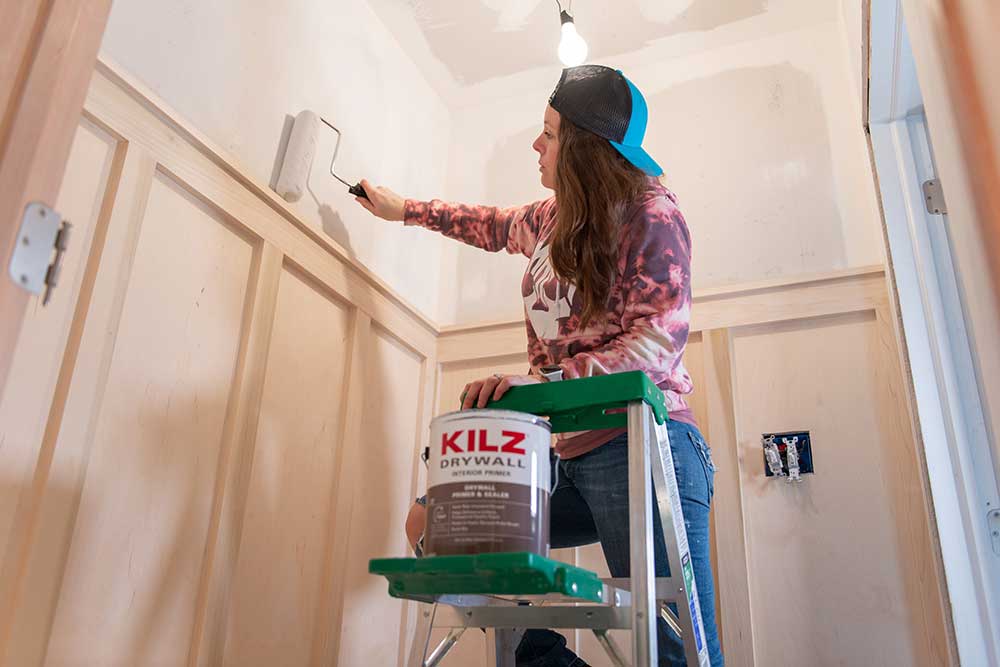
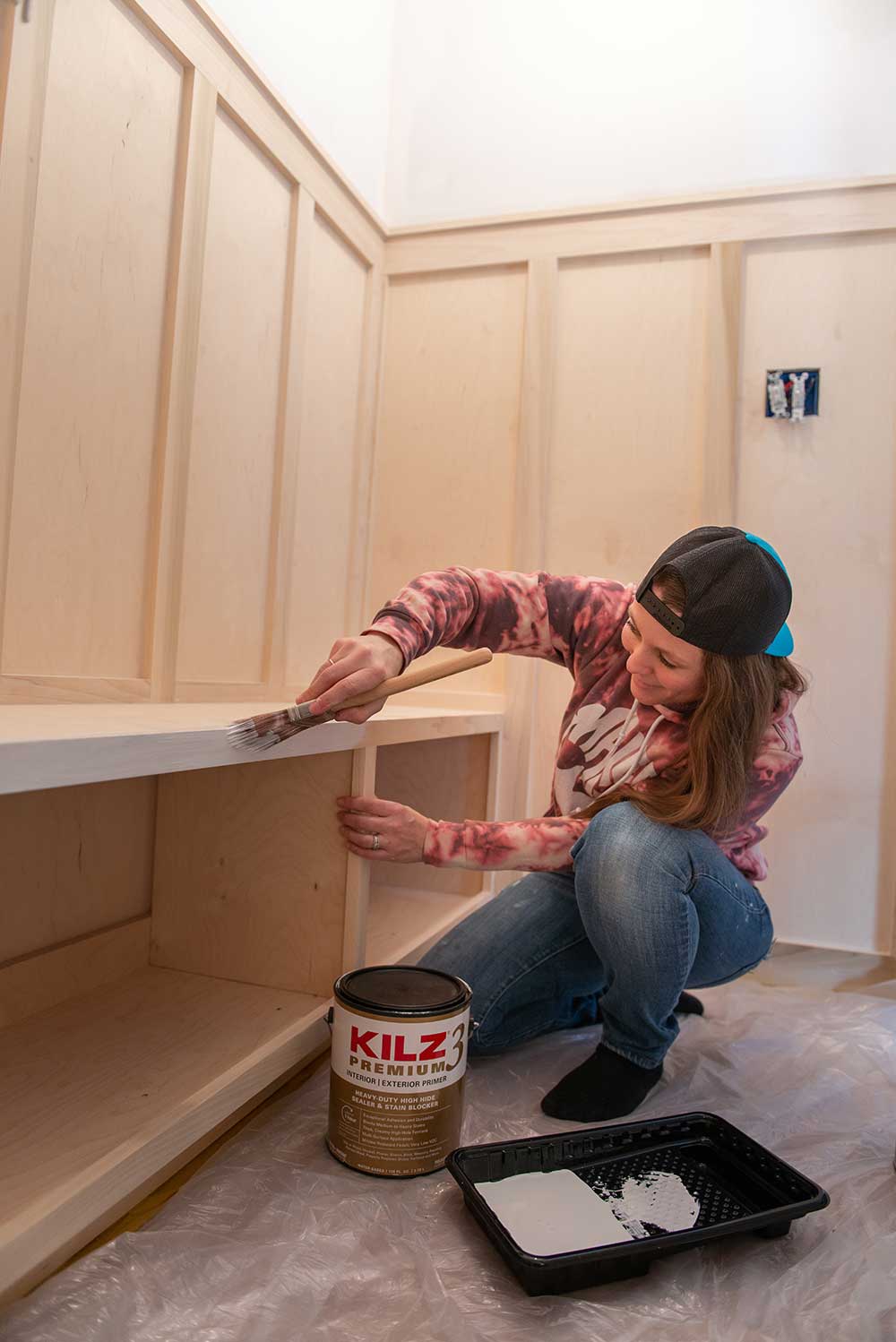
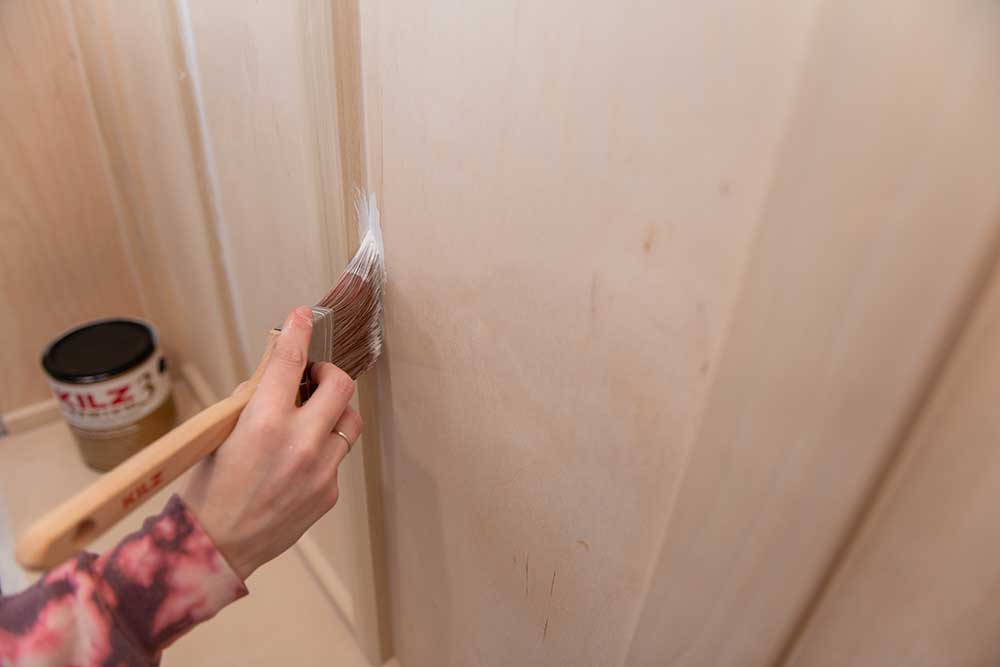
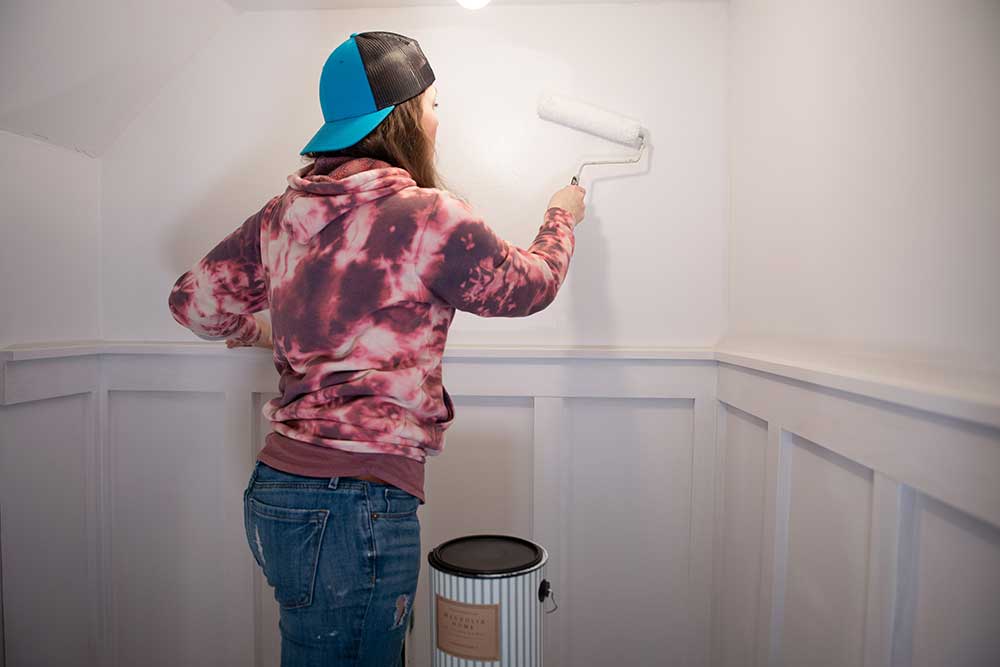
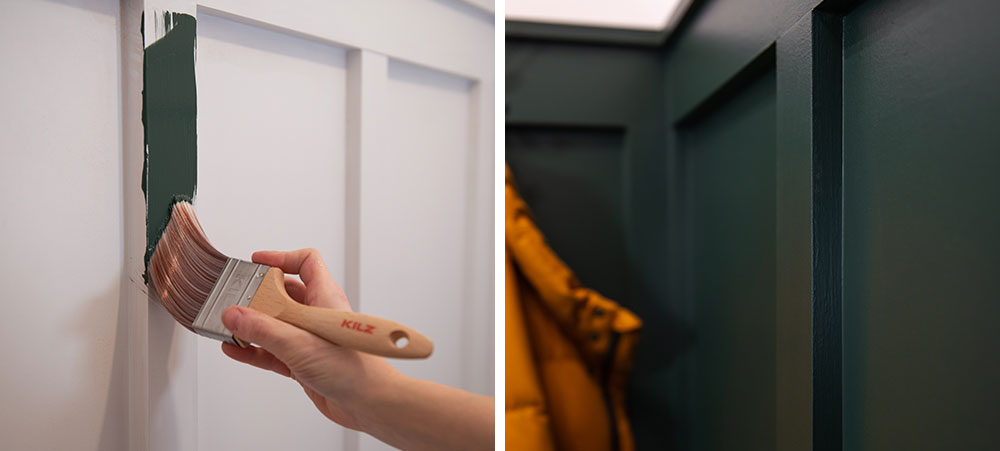
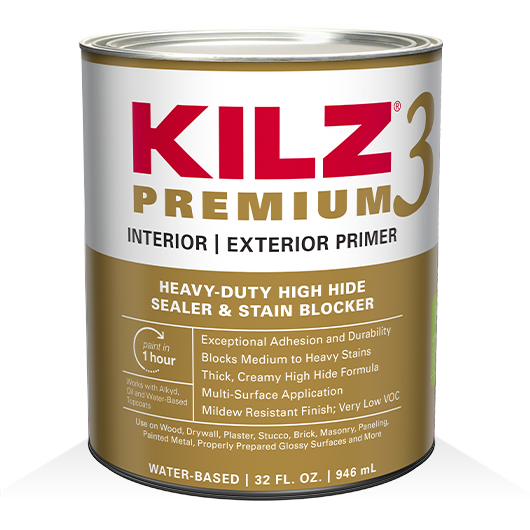

join the conversation:
SHARE this post: